Paul van Yperen's Blog, page 98
January 27, 2023
La Collectionneuse: Actresses as Asian characters
During the golden age of the movies, it was usual for white actors to don 'Asian-esque' makeup and costuming to play East-Asian roles. In fact, the film world followed a tradition inherited from theatre and opera. At the time, that practice barely raised an eyebrow. Luise Rainer even got an Oscar for her performance in The Good Earth. Today, it is called "Yellowface". It is heavily critised and is deemed as offensive, as most of modern audiences see it as a dehumanization of Asian people and a perpetuation of racist stereotypes. Here are several examples of actresses having played East-Asians in the cinema.
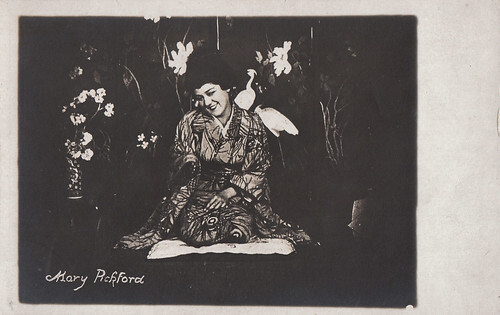
Vintage postcard. Mary Pickford , as Japanese character Cho-Cho-San, in Madame Butterfly (Sidney Olcott, 1915).
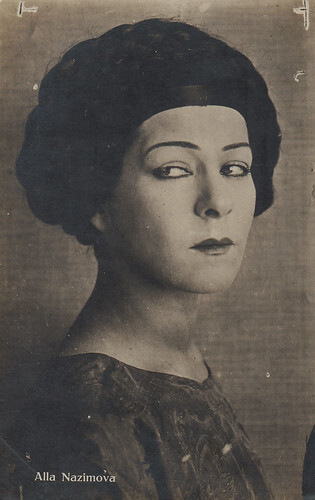
Spanish postcard. Alla Nazimova plays Mahlee, born from a Chinese mother and an English father, in The Red Lantern (Albert Capellani, 1919).
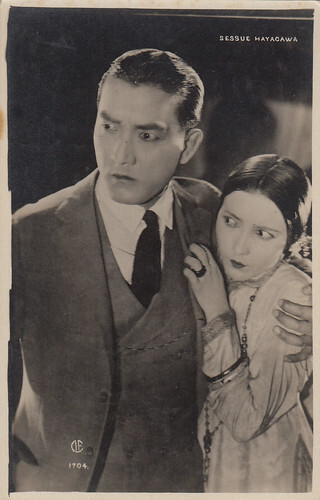
Mexican postcard, no. 1704. Bessie Love , as Chinese character Hyacinth, and Sessue Hayakawa in The Vermilion Pencil (Norman Dawn, 1922).
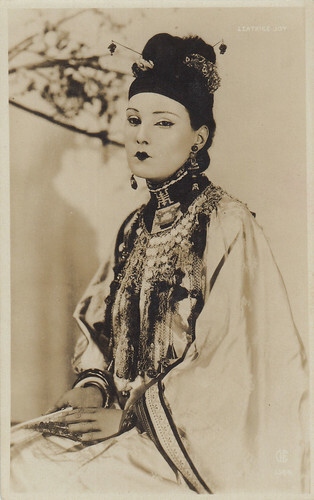
Mexican postcard, no. 1384. Leatrice Joy , as Chinese character Taou Yuen, in Java Head (George Melford, 1923).
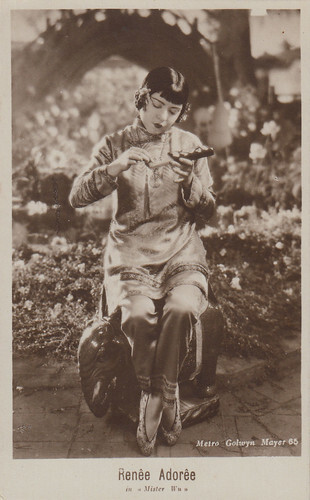
Italian postcard by G.B. Falci, Milano, no. 65. Photo: MGM. Renée Adorée , as Chinese character Nang Ping, in Mr. Wu (William Nigh, 1927).
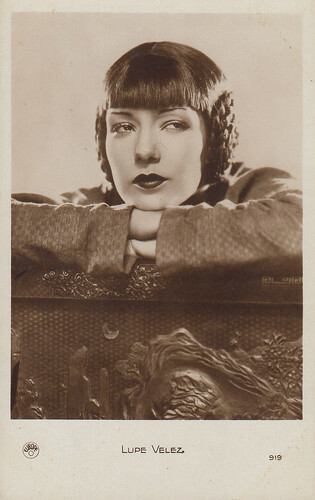
French postcard by Europe, no. 919. Lupe Velez , as Chinese character Ming Toy, in East Is West (Monta Bell, 1930).
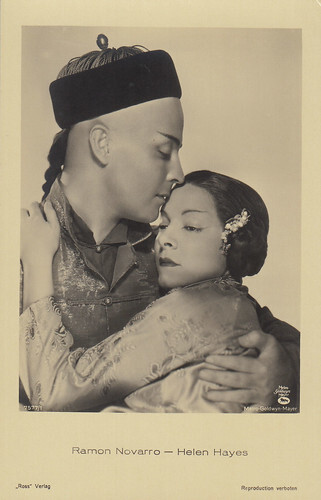
German postcard by Ross Verlag, no. 7577/1, 1932-1933. Photo: MGM. Helen Hayes, as Chinese character Lien Wha, and Ramon Novarro in The Son-Daughter (Clarence Brown, 1932).
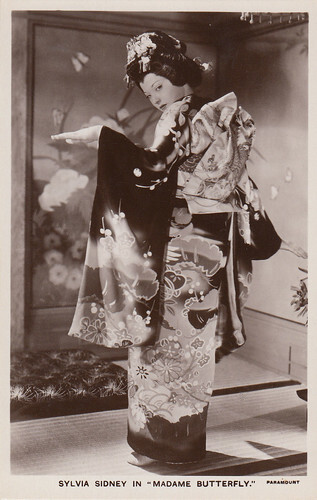
Dutch postcard by M. Bonnist & Zonen, Amsterdam, no. B226. Photo: Paramount. Sylvia Sidney , as Japanese character Cho-Cho-San, in Madame Butterfly (Marion Gering, 1932).
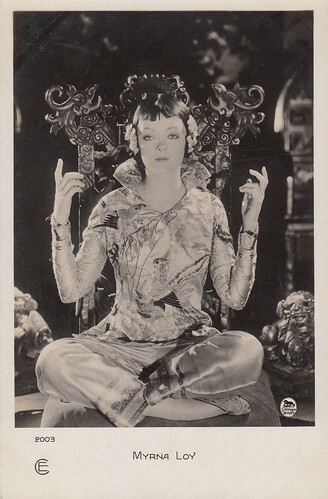
French postcard by Cinémagazine-Sélection, Paris, no. 2003. Photo: MGM. Myrna Loy , as Chinese character Fah Lo See, in The Mask of Fu Manchu (Charles Brabin, 1932).
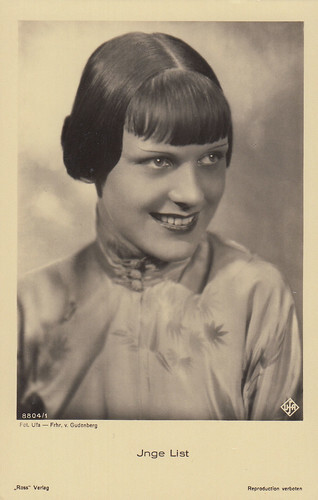
German postcard by Ross Verlag, no. 8804/1, 1933-1934. Photo: Frhr. v. Gudenberg / Ufa. Inge List, as Chinese maidservant Mian Li, in Prinzessin Turandot/Princess Turandot (Gerhard Lamprecht, 1934).
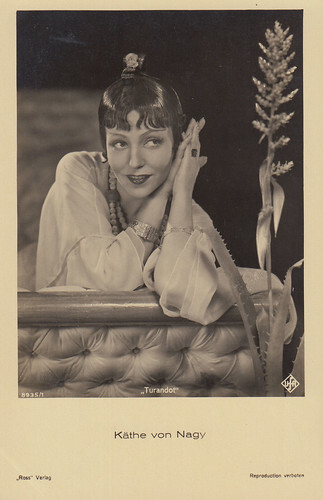
German postcard by Ross Verlag, no. 8935/1, 1933-1934. Photo: Ufa. Käthe von Nagy , as Chinese princess Turandot, in Prinzessin Turandot/Princess Turandot (Gerhard Lamprecht, 1934).
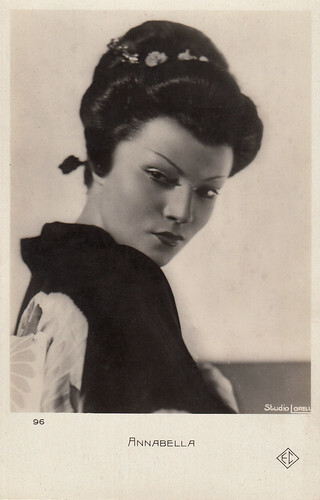
French postcard by Editions Chantal, Paris, no. 96. Photo: Studio Lorelle. Annabella , as Japanese character Mitsouko Yorisaka, in La bataille/The Battle (Nicolas Farkas, Viktor Tourjansky, 1933).
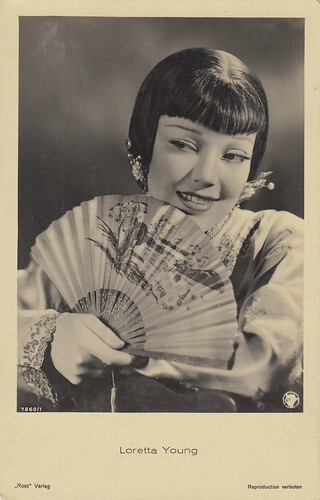
German postcard by Ross Verlag, no. 7960/1, 1932-1933. Photo: First National. Loretta Young, as the Chinese character Sun Toya San, in The Hatchet Man (William A. Wellman, 1932).
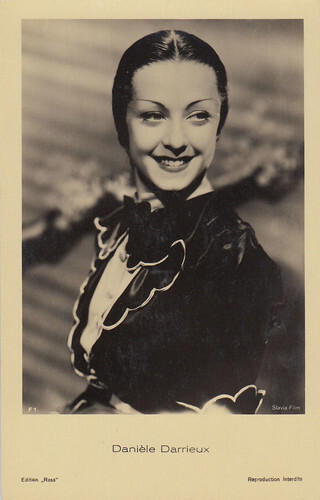
French-German postcard by Edition Ross, no. F1. Photo: Slavia Film. Danielle Darrieux , as Japanese character Youki, in the French-language version of Port Arthur (Nicolas Farkas, 1936).
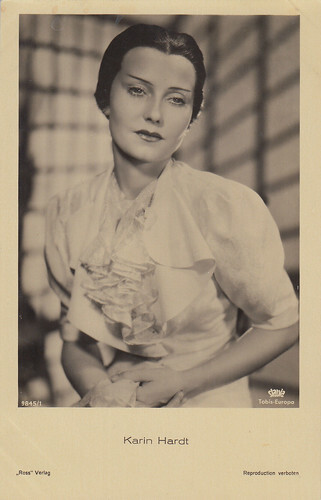
German postcard by Ross Verlag, no. 9845/1, 1935-1936. Photo: Slavia / Tobis-Europa. Karin Hardt , as Japanese character Youki, in the German-language version of Port Arthur (Nicolas Farkas, 1936).
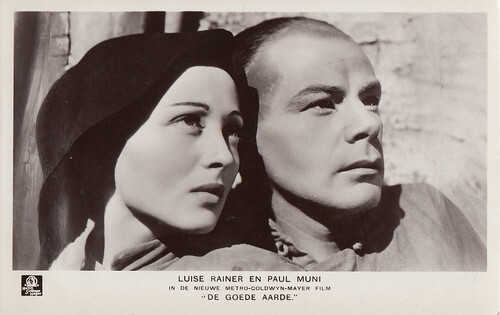
Dutch postcard by M. Bonnist & Zonen, Amsterdam, no. B473. Photo: Metro-Goldwyn-Mayer. Luise Rainer , as Chinese character O-Lan, and Paul Muni in The Good Earth (Sidney Franklin, 1937).
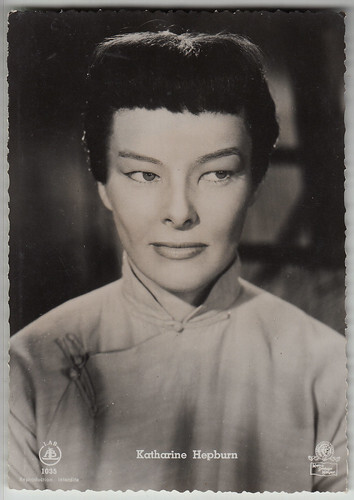
Belgian postcard by Editions L.A.B., Bruxelles, no. 1035. Photo: Metro-Goldwyn-Mayer. Katharine Hepburn , as Chinese character Jade Tan, in Dragon Seed (Harold S. Bucquet, Jack Conway, 1944).
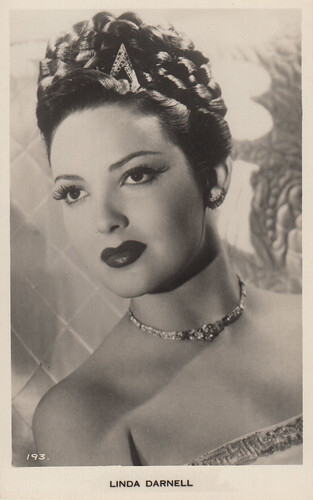
British postcard by Valentine’s, no. 193. Photo: Twentieth Century Fox. Linda Darnell , as Burmese character Tuptim, in Anna and the King of Siam (John Cromwell, 1946).
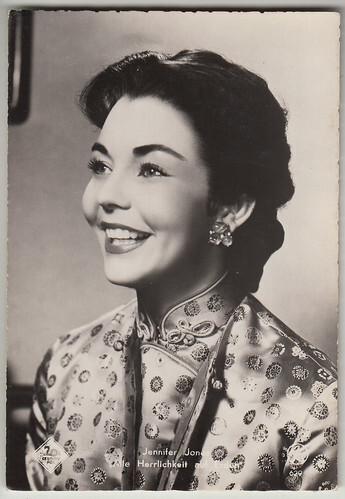
Austrian postcard by Kellner-Fotokarten, Wien, no. 629. Photo: 20th Century Fox. Jennifer Jones as Han Suyin, born from a Chinese father and a Belgian mother, in Love Is a Many-Splendored Thing (Henry King, 1955).
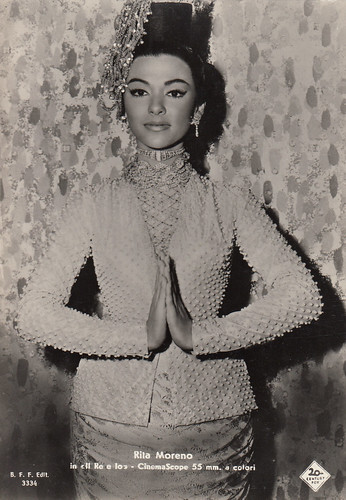
Italian postcard by Ballerini & Fratini, Firenze, no. 3334. Photo: 20th Century Fox. Rita Moreno, as Burmese character Tuptim, in The King and I (Walter Lang, 1956).
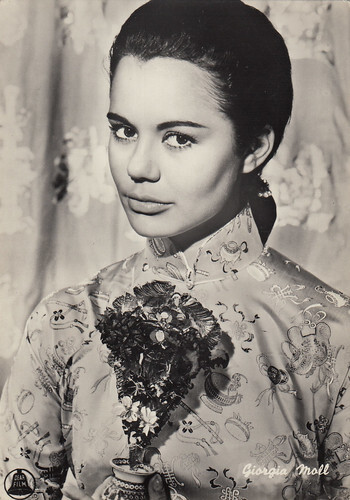
Italian postcard by Bromofoto, Milano, no. 1366. Photo: Dear Film. Giorgia Moll , as Vietnamese character Phuong, in The Quiet American (Joseph L. Mankiewicz, 1958).
Text and postcards: Marlene Pilaete.

Vintage postcard. Mary Pickford , as Japanese character Cho-Cho-San, in Madame Butterfly (Sidney Olcott, 1915).

Spanish postcard. Alla Nazimova plays Mahlee, born from a Chinese mother and an English father, in The Red Lantern (Albert Capellani, 1919).

Mexican postcard, no. 1704. Bessie Love , as Chinese character Hyacinth, and Sessue Hayakawa in The Vermilion Pencil (Norman Dawn, 1922).

Mexican postcard, no. 1384. Leatrice Joy , as Chinese character Taou Yuen, in Java Head (George Melford, 1923).

Italian postcard by G.B. Falci, Milano, no. 65. Photo: MGM. Renée Adorée , as Chinese character Nang Ping, in Mr. Wu (William Nigh, 1927).

French postcard by Europe, no. 919. Lupe Velez , as Chinese character Ming Toy, in East Is West (Monta Bell, 1930).

German postcard by Ross Verlag, no. 7577/1, 1932-1933. Photo: MGM. Helen Hayes, as Chinese character Lien Wha, and Ramon Novarro in The Son-Daughter (Clarence Brown, 1932).

Dutch postcard by M. Bonnist & Zonen, Amsterdam, no. B226. Photo: Paramount. Sylvia Sidney , as Japanese character Cho-Cho-San, in Madame Butterfly (Marion Gering, 1932).

French postcard by Cinémagazine-Sélection, Paris, no. 2003. Photo: MGM. Myrna Loy , as Chinese character Fah Lo See, in The Mask of Fu Manchu (Charles Brabin, 1932).

German postcard by Ross Verlag, no. 8804/1, 1933-1934. Photo: Frhr. v. Gudenberg / Ufa. Inge List, as Chinese maidservant Mian Li, in Prinzessin Turandot/Princess Turandot (Gerhard Lamprecht, 1934).

German postcard by Ross Verlag, no. 8935/1, 1933-1934. Photo: Ufa. Käthe von Nagy , as Chinese princess Turandot, in Prinzessin Turandot/Princess Turandot (Gerhard Lamprecht, 1934).

French postcard by Editions Chantal, Paris, no. 96. Photo: Studio Lorelle. Annabella , as Japanese character Mitsouko Yorisaka, in La bataille/The Battle (Nicolas Farkas, Viktor Tourjansky, 1933).

German postcard by Ross Verlag, no. 7960/1, 1932-1933. Photo: First National. Loretta Young, as the Chinese character Sun Toya San, in The Hatchet Man (William A. Wellman, 1932).

French-German postcard by Edition Ross, no. F1. Photo: Slavia Film. Danielle Darrieux , as Japanese character Youki, in the French-language version of Port Arthur (Nicolas Farkas, 1936).

German postcard by Ross Verlag, no. 9845/1, 1935-1936. Photo: Slavia / Tobis-Europa. Karin Hardt , as Japanese character Youki, in the German-language version of Port Arthur (Nicolas Farkas, 1936).

Dutch postcard by M. Bonnist & Zonen, Amsterdam, no. B473. Photo: Metro-Goldwyn-Mayer. Luise Rainer , as Chinese character O-Lan, and Paul Muni in The Good Earth (Sidney Franklin, 1937).

Belgian postcard by Editions L.A.B., Bruxelles, no. 1035. Photo: Metro-Goldwyn-Mayer. Katharine Hepburn , as Chinese character Jade Tan, in Dragon Seed (Harold S. Bucquet, Jack Conway, 1944).

British postcard by Valentine’s, no. 193. Photo: Twentieth Century Fox. Linda Darnell , as Burmese character Tuptim, in Anna and the King of Siam (John Cromwell, 1946).

Austrian postcard by Kellner-Fotokarten, Wien, no. 629. Photo: 20th Century Fox. Jennifer Jones as Han Suyin, born from a Chinese father and a Belgian mother, in Love Is a Many-Splendored Thing (Henry King, 1955).

Italian postcard by Ballerini & Fratini, Firenze, no. 3334. Photo: 20th Century Fox. Rita Moreno, as Burmese character Tuptim, in The King and I (Walter Lang, 1956).

Italian postcard by Bromofoto, Milano, no. 1366. Photo: Dear Film. Giorgia Moll , as Vietnamese character Phuong, in The Quiet American (Joseph L. Mankiewicz, 1958).
Text and postcards: Marlene Pilaete.
Published on January 27, 2023 22:00
January 26, 2023
Priscilla Dean
Priscilla Dean (1896-1987) was an American actress on the silent screen. Between 1912 and 1928, she appeared in some 70 silent films, and later in five sound films. She is best known for her Universal films under the direction of horror specialist Tod Browning.
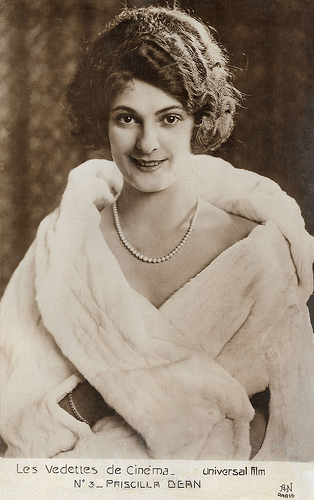
French postcard by A.N., Paris, in the Les Vedettes de Cinéma series, no. 3. Photo: Universal Film.
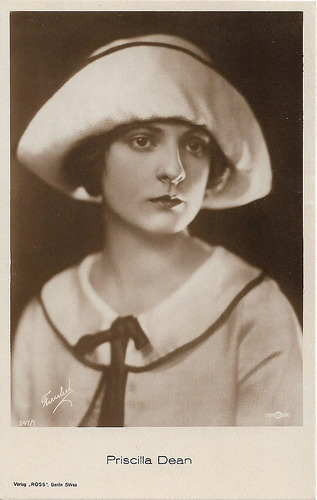
German postcard by Ross Verlag, no. 548/1, 1919-1924. Photo: Roman Freulich / Unfilman.
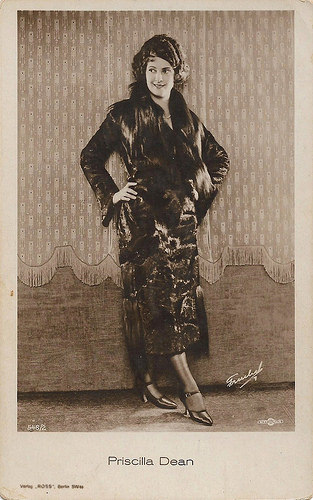
German postcard by Ross Verlag, no. 548/2, 1919-1924. Photo: Roman Freulich / Unfilman.
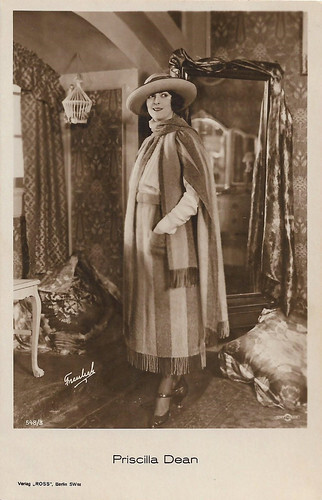
German postcard by Ross Verlag, no. 548/3, 1919-1924. Photo: Roman Freulich / Unfilman.
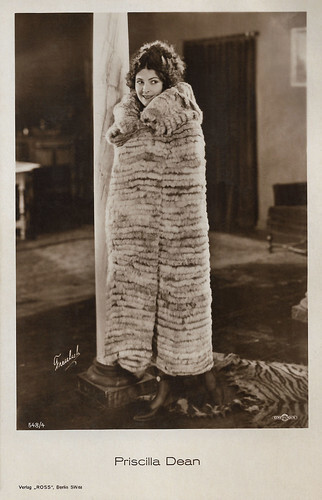
German postcard by Verlag Ross, no. 548/4, 1919-1924. Photo: Roman Freulich / Unfilman.
David Wark Griffith
Priscilla Dean was born in 1896 in New York City as the daughter of theatre actors. Her mother was popular stage actress May Preston Dean. From when she was four, Priscilla played in her parents' productions. As a child, she pursued a stage career at the same time as being educated at a convent school until the age of fourteen. By age 10, she was a seasoned professional.
Dean made her film debut and appeared in two short films, released in 1912. One of them was directed by D. W. Griffith for the Biograph company, A Blot under 'Scutcheon (1912). Until 1928, she contributed to 68 American silent films, including many short films directed by Jack Dillon in the mid-1910s for the Vogue Company.
From 1916 onwards, she worked for IMP, which was later merged with other film companies into Universal. She played the female lead in the Eddie Lyons & Lee Moran comedies, directed by Louis Chaudet for Nestor, another company which was merged into Universal.
In 1917 she acted in films by Lois Weber such as Even As You and I (1917) and The Hand That Rocks the Cradle (1917). Her appearance in the action serial The Gray Ghost (Stuart Paton, 1917) opposite Eddie Polo propelled her to stardom, and she began appearing in many of Universal's most prestigious productions.
Greta de Groat at Unsung Divas : "Priscilla Dean was a very unlikely diva. Her photos show a plain but cheerful-looking woman, with rather heavy features, a crooked grin, and an unfashionably curvaceous figure. But on the screen her intensity is unmatched."
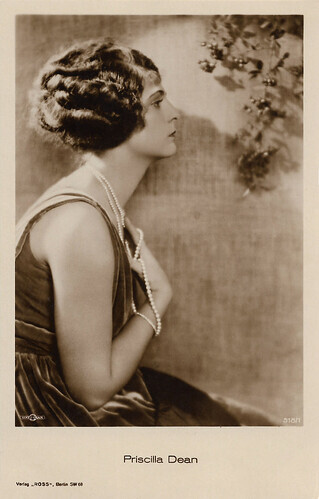
German postcard by Verlag Ross, no. 518/1, 1919-1924. Photo: Unfilman.
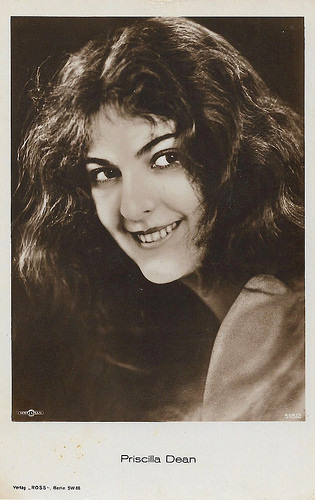
German postcard by Ross Verlag, no. 518/2, 1919-1924. Photo: Unfilman.
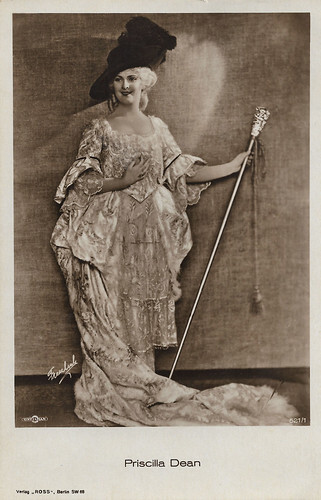
German postcard by Verlag Ross, no. 521/1, 1919-1924. Photo: Freulich / Unfilman.
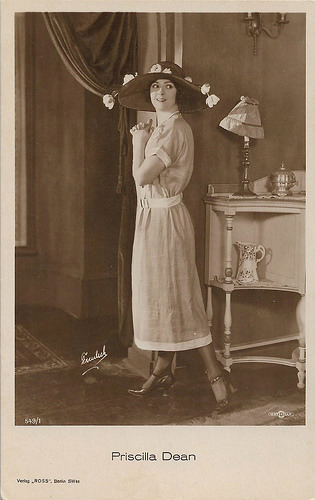
German postcard by Ross Verlag, no. 549/1, 1919-1924. Photo: Roman Freulich / Unfilman.
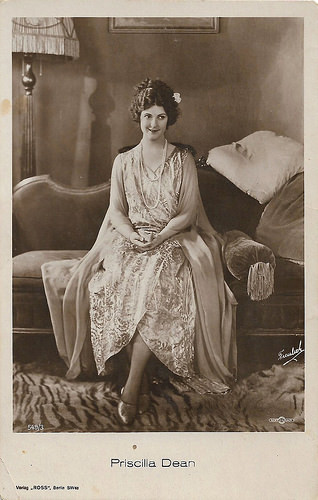
German postcard by Ross Verlag, no. 549/3, 1919-1924. Photo: Roman Freulich / Unfilman.
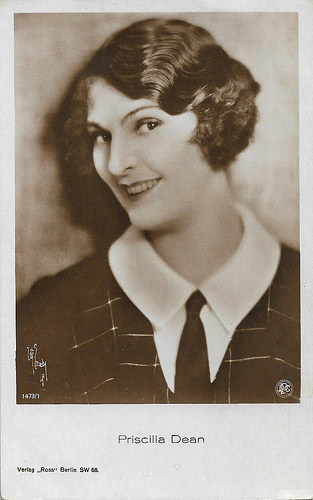
German postcard by Ross Verlag, no. 1473/1, 1927-1928. Photo: Walter F. Seely, Los Angeles / P.D.C.
Tod Browning
Priscilla Dean is best known for her participation, between 1918 and 1923, in nine Universal films by Tod Browning. These films include The Wicked Darling (1919) in which she played a pair of pickpockets with Lon Chaney , The Virgin of Stamboul (1920) with Wallace Beery , Outside the Law (1920), with Lon Chaney , Under Two Flags (1922), and White Tiger (1923), with Raymond Griffith.
Browning unleashed her talent. Her performance in Outside the Law (1920) is "startlingly fierce", according to Greta de Groat. In the French Foreign Legion melodrama Under two Flags (1922) she played Cigarette, a role re-created in a sound version by Claudette Colbert . In The Virgin of Stamboul and Outside the Law, Dean played together with Wheeler Oakman, who was also under contract at Universal and was for a time her husband.
After 1923, Dean worked for several companies: she did quite a few films at Metropolitan, a few shorts at Hal Roach such as Slipping Wives (Fred Guiol, 1927), with Laurel & Hardy , and one or two productions at Hunt Stromberg and Columbia.
The coming of sound damaged her career. By the early 1930s, she was appearing in low-budget films for small independent studios. Dean retired permanently from the screen after five talking pictures (three shorts in 1931 and two feature films in 1932). Her last film was Klondike (Phil Rosen, 1932) with Thelma Todd and Lyle Talbot. Great de Groat: "Her starring career was brief, but there was nobody else quite like her."
Priscilla Dean was first married to Wheeler Oakman but they divorced in the mid-1920s. In 1928, she married Leslie Arnold in Mexico. Arnold was divorced, but one court called this invalid, making him a bigamist, but in the end, that verdict was overruled. Lt. Leslie Arnold made history by flying around the world in 1924. Dean and Arnold remained married until his death in the 1960s. They had no children. In 1987, Priscilla Dean died at her home in Leonia, New Jersey, after the complications of a fall one year earlier. She was 91.
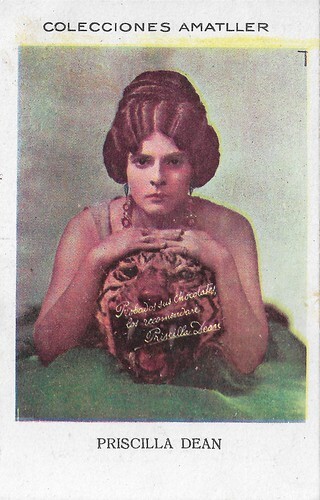
Spanish collectors card in the Collecciones Amatller Series, Series S, artist 24, no. 58, by Chocolate Amatller.
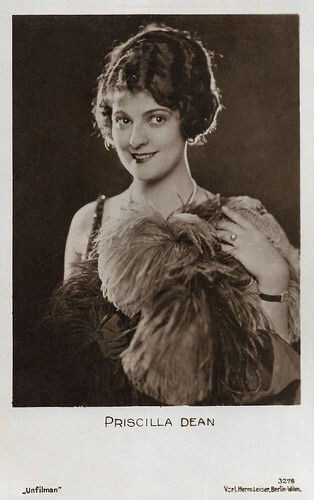
German postcard by Verlag Hermann Leiser, Berlin-Wilm., no. 3276. Photo: Unfilman.
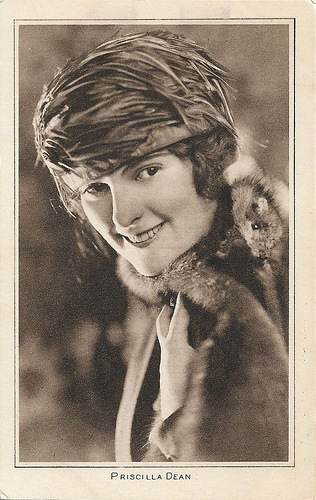
British postcard.
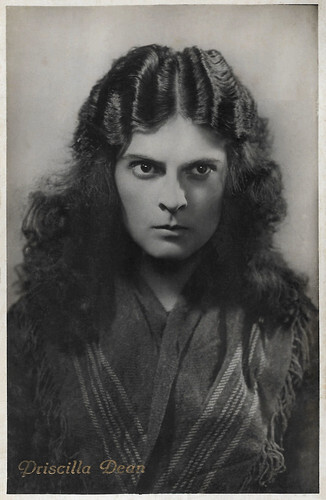
Italian postcard by G.B. Falci Editore, Milano, no. 429. Priscilla Dean in The Flame of Life (Hobart Henley, 1923).
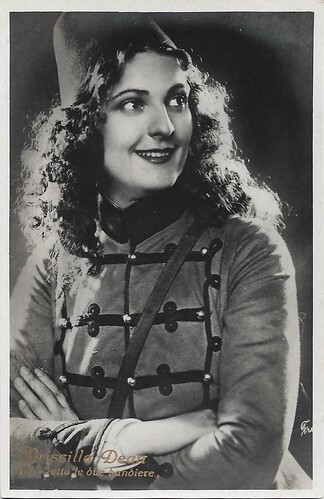
Italian postcard by G.B. Falci, Milano, no. 442. Photo: Freulich / Universal. Priscilla Dean in Under Two Flags (Tod Browning, 1922).
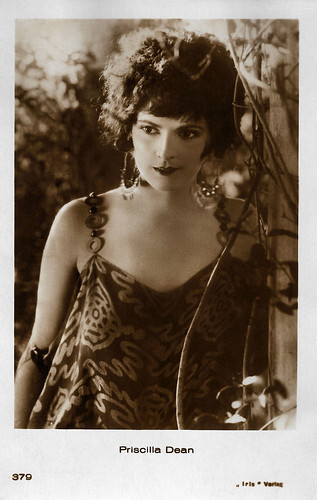
Austrian postcard by Iris-Verlag, no. 379. Priscilla Dean in A Cafe in Cairo (Chester Withey, 1924).
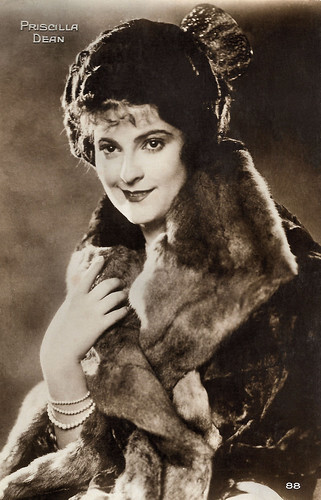
French postcard by Cinémagazine-Edition, no. 88.
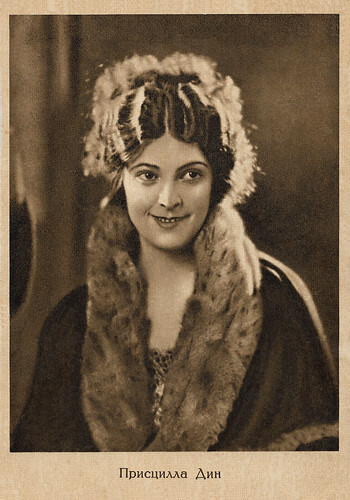
Russian postcard by Goznak, Moscow, series no. 6, no. A 11833, 1928. Published in an edition of 30,000 cards.
Sources: Greta de Groat (Unsung Divas), Michael Barson (Encyclopaedia Britannica), Silent Hollywood, Los Angeles Times, Wikipedia (Italian and English) and .

French postcard by A.N., Paris, in the Les Vedettes de Cinéma series, no. 3. Photo: Universal Film.

German postcard by Ross Verlag, no. 548/1, 1919-1924. Photo: Roman Freulich / Unfilman.

German postcard by Ross Verlag, no. 548/2, 1919-1924. Photo: Roman Freulich / Unfilman.

German postcard by Ross Verlag, no. 548/3, 1919-1924. Photo: Roman Freulich / Unfilman.

German postcard by Verlag Ross, no. 548/4, 1919-1924. Photo: Roman Freulich / Unfilman.
David Wark Griffith
Priscilla Dean was born in 1896 in New York City as the daughter of theatre actors. Her mother was popular stage actress May Preston Dean. From when she was four, Priscilla played in her parents' productions. As a child, she pursued a stage career at the same time as being educated at a convent school until the age of fourteen. By age 10, she was a seasoned professional.
Dean made her film debut and appeared in two short films, released in 1912. One of them was directed by D. W. Griffith for the Biograph company, A Blot under 'Scutcheon (1912). Until 1928, she contributed to 68 American silent films, including many short films directed by Jack Dillon in the mid-1910s for the Vogue Company.
From 1916 onwards, she worked for IMP, which was later merged with other film companies into Universal. She played the female lead in the Eddie Lyons & Lee Moran comedies, directed by Louis Chaudet for Nestor, another company which was merged into Universal.
In 1917 she acted in films by Lois Weber such as Even As You and I (1917) and The Hand That Rocks the Cradle (1917). Her appearance in the action serial The Gray Ghost (Stuart Paton, 1917) opposite Eddie Polo propelled her to stardom, and she began appearing in many of Universal's most prestigious productions.
Greta de Groat at Unsung Divas : "Priscilla Dean was a very unlikely diva. Her photos show a plain but cheerful-looking woman, with rather heavy features, a crooked grin, and an unfashionably curvaceous figure. But on the screen her intensity is unmatched."

German postcard by Verlag Ross, no. 518/1, 1919-1924. Photo: Unfilman.

German postcard by Ross Verlag, no. 518/2, 1919-1924. Photo: Unfilman.

German postcard by Verlag Ross, no. 521/1, 1919-1924. Photo: Freulich / Unfilman.

German postcard by Ross Verlag, no. 549/1, 1919-1924. Photo: Roman Freulich / Unfilman.

German postcard by Ross Verlag, no. 549/3, 1919-1924. Photo: Roman Freulich / Unfilman.

German postcard by Ross Verlag, no. 1473/1, 1927-1928. Photo: Walter F. Seely, Los Angeles / P.D.C.
Tod Browning
Priscilla Dean is best known for her participation, between 1918 and 1923, in nine Universal films by Tod Browning. These films include The Wicked Darling (1919) in which she played a pair of pickpockets with Lon Chaney , The Virgin of Stamboul (1920) with Wallace Beery , Outside the Law (1920), with Lon Chaney , Under Two Flags (1922), and White Tiger (1923), with Raymond Griffith.
Browning unleashed her talent. Her performance in Outside the Law (1920) is "startlingly fierce", according to Greta de Groat. In the French Foreign Legion melodrama Under two Flags (1922) she played Cigarette, a role re-created in a sound version by Claudette Colbert . In The Virgin of Stamboul and Outside the Law, Dean played together with Wheeler Oakman, who was also under contract at Universal and was for a time her husband.
After 1923, Dean worked for several companies: she did quite a few films at Metropolitan, a few shorts at Hal Roach such as Slipping Wives (Fred Guiol, 1927), with Laurel & Hardy , and one or two productions at Hunt Stromberg and Columbia.
The coming of sound damaged her career. By the early 1930s, she was appearing in low-budget films for small independent studios. Dean retired permanently from the screen after five talking pictures (three shorts in 1931 and two feature films in 1932). Her last film was Klondike (Phil Rosen, 1932) with Thelma Todd and Lyle Talbot. Great de Groat: "Her starring career was brief, but there was nobody else quite like her."
Priscilla Dean was first married to Wheeler Oakman but they divorced in the mid-1920s. In 1928, she married Leslie Arnold in Mexico. Arnold was divorced, but one court called this invalid, making him a bigamist, but in the end, that verdict was overruled. Lt. Leslie Arnold made history by flying around the world in 1924. Dean and Arnold remained married until his death in the 1960s. They had no children. In 1987, Priscilla Dean died at her home in Leonia, New Jersey, after the complications of a fall one year earlier. She was 91.

Spanish collectors card in the Collecciones Amatller Series, Series S, artist 24, no. 58, by Chocolate Amatller.

German postcard by Verlag Hermann Leiser, Berlin-Wilm., no. 3276. Photo: Unfilman.

British postcard.

Italian postcard by G.B. Falci Editore, Milano, no. 429. Priscilla Dean in The Flame of Life (Hobart Henley, 1923).

Italian postcard by G.B. Falci, Milano, no. 442. Photo: Freulich / Universal. Priscilla Dean in Under Two Flags (Tod Browning, 1922).

Austrian postcard by Iris-Verlag, no. 379. Priscilla Dean in A Cafe in Cairo (Chester Withey, 1924).

French postcard by Cinémagazine-Edition, no. 88.

Russian postcard by Goznak, Moscow, series no. 6, no. A 11833, 1928. Published in an edition of 30,000 cards.
Sources: Greta de Groat (Unsung Divas), Michael Barson (Encyclopaedia Britannica), Silent Hollywood, Los Angeles Times, Wikipedia (Italian and English) and .
Published on January 26, 2023 22:00
January 25, 2023
Heinz Drache
Heinz Drache (1923-2002) was the most in-vogue screen cop of post-war German cinema. He first established his reputation in the role of the charismatic Inspector Yates in Francis Durbridge's TV miniseries Das Halstuch (1962) and continued in the same vein apprehending villains in a series of Edgar Wallace Krimis such as Der Zinker/The Squeaker (1963) and Der Hexer/The Mysterious Magician (1964). He appeared in 42 films between 1953 and 2002.

West German postcard by Ufa/Film-Foto, Berlin-Tempelhof, no. FK 4719 Photo: Arthur Grimm.

German postcard by Agfa, no. 525. Photo: Panorama Films. Renate Holm and Heinz Drache in Kein Auskommen mit dem Einkommen/Short of Cash (Herbert B. Fredersdorf, 1957).
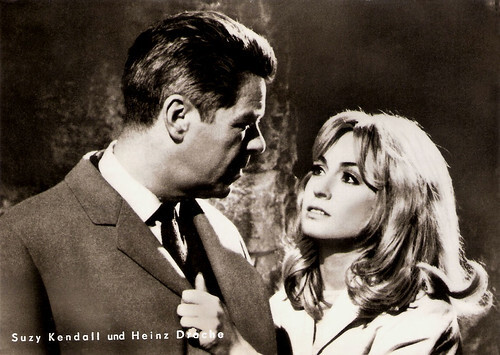
East-German postcard by Progress, Berlin, no. 131/72. Photo: Suzy Kendall and Heinz Drache in Das Rätsel des silbernen Dreieck/Circus of Fear (Werner Jacobs (German version), John Llewellyn Moxey (Eglish version), 1966).
Gaining fame with Edgar Wallace Krimis
Heinz Drache was born in Essen, Germany, in 1923. Heinz did his schooling at the Alfred-Krupp-Gymnasium in Essen-Holsterhausen. He began his acting career in the theatre and acted in Nuremberg, Düsseldorf and Berlin. In Berlin, he met Gustaf Gründgens . This later brought him to Düsseldorf, where Drache was contracted for a role in Friedrich von Schiller's 'Die Räuber' (The Robbers) and in the play 'Der Schatten', which premiered in 1947. His colleagues included Käthe Gold , Marianne Hoppe , Gustav Knuth and Elisabeth Flickenschildt.
As early as the 1950s, Drache starred in numerous films and television productions. He gained fame in the 1960s in crime films based on Edgar Wallace. The first was Der Rächer/The Avenger (Karl Anton, 1960) with Ingrid van Bergen. Film critic Leonard Maltin awarded the film two and a half out of four stars, calling it "[an] Above-par shocker".
Soon followed more Wallace adaptations such as Die Tür mit den sieben Schlössern/The Door with Seven Locks (Alfred Vohrer, 1962), Der Zinker/The Squeaker (Alfred Vohrer, 1963) and Der Hexer/The Mysterious Magician (Alfred Vohrer, 1964). In 1962, he also co-starred with Albert Lieven on television in the six-part blockbuster Das Halstuch/The Scarf (Hans Quest, 1962), based on a novel by Francis Durbridge.
Because of his popularity, Drache received the Golden Bravo Otto as the most popular TV star in the 1962 readers' poll of the youth magazine BRAVO. Apart from the Krimi films he also starred in the British family film Sandy the Seal (Robert Lynn, 1965/1968) with Marianne Koch . The film was shot in South Africa in Technicolor and Techniscope II with sequences shot on Seal Island, South Africa.
He also appeared in the British/West German co-production of The Brides of Fu Manchu/Die 13 Sklavinnen des Dr. Fu Man Chu (Don Sharp, 1966). This adventure crime film was based on the fictional Chinese villain Dr. Fu Manchu, created by Sax Rohmer and played by Christopher Lee .
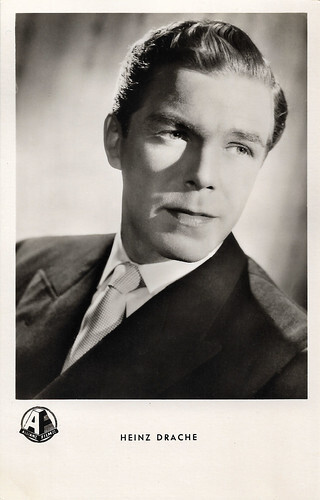
West German postcard by Kunst und Bild, Berlin, no. A 1068. Photo: Allianz Film. Heinz Drache in Bei dir war es immer so schön/It Was Always So Nice with You (Hans Wolff, 1954).
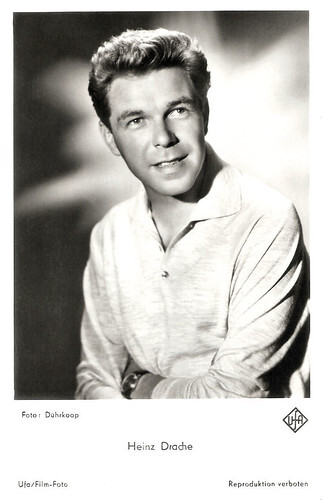
West German postcard by Ufa/Film-Foto, Berlin-Tempelhof, no. FK 3994. Photo: Dührkoop.
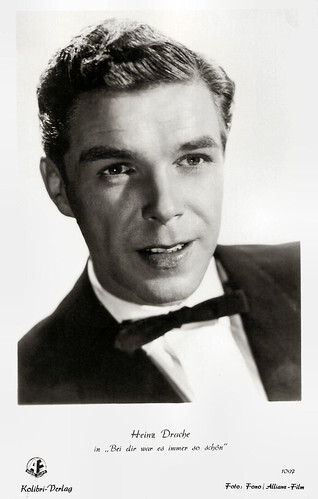
West German postcard by Kolibri-Verlag, Minden Westf., no. FK 1097. Photo: Fono / Allianz-Film. Heinz Drache in Bei dir war es immer so schön/It Was Always So Nice with You (Hans Wolff, 1954).
The German voice of Frank Sinatra
Since 1946, Heinz Drache worked intensively as a radio play actor, mainly at NWDR Cologne and WDR. He was one of the lead actors in the radio plays 'Das kurze glückliche Leben des Francis Macomber' (1951) based on Ernest Hemingway or in 'Der Untertan' (1971) based on Heinrich Mann.
Drache worked as a voice actor and dubbed such Hollywood stars as Kirk Douglas , Glenn Ford , Frank Sinatra , Sean Connery and Richard Widmark . He also worked on German versions of Apocalypse Now (Francis Ford Coppola, 1979) as the voice of Robert Duvall and The Third Man (Carol Reed, 1949) as the voice of Trevor Howard .
From 1985 to 1989, he also was inspector Bülow in six episodes of the popular Krimi series Tatort/Crime Scene. 'Don Flanello' was Drache's nickname because of his preference for tailored suits.
His last screen role was in the TV film Die Kristallprinzessin/The Crystal Princess (Rolf von Sydow, 2002) with Denise Zich and Anja Kruse. Heinz Drache was married to Rosemarie Eveline Nordmann from 1957 till his death. They had three children. His daughter Angelika, born in 1948, was from an earlier relationship with actress Edith Teichmann.
Heinz Drache passed away in 2002 at the age of 79. He died of lung cancer in a Berlin hospital after several months of illness. His grave is in the Dahlem in Veld cemetery.
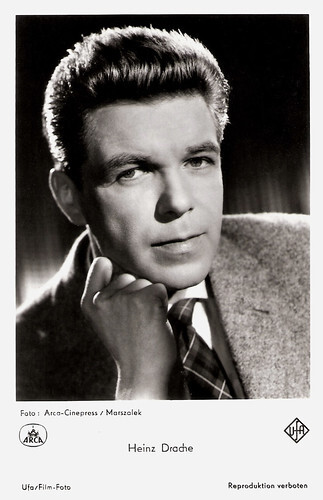
West German postcard by Ufa/Film-Foto, Berlin-Tempelhof, no. FK 4055. Photo: Arca / Cinepress / Marszalek. Heinz Drache in Madeleine Tel. 13 62 11/Naked in the Night (Kurt Meisel, 1958).
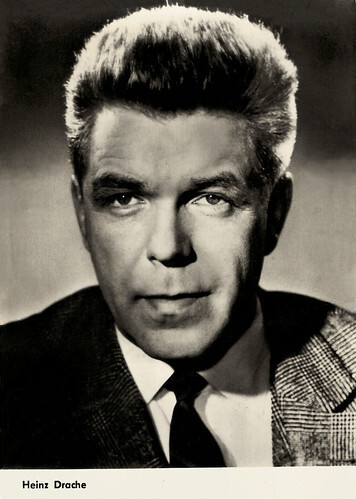
East-German postcard by VEB Progress Film-Vertrieb, Berlin, no. 1705, 1962. Heinz Drache in Die Frau am dunklen Fenster/The woman at the dark window (Franz Peter Wirth, 1960).
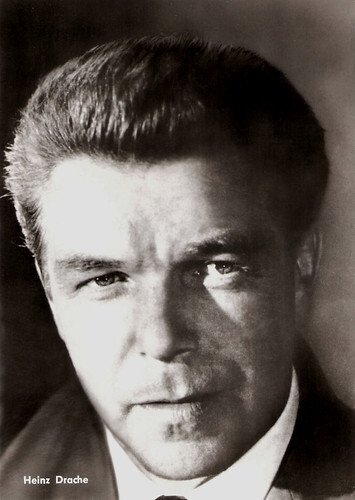
East-German postcard by VEB Progress Film-Vertrieb, Berlin, no. 134/70.
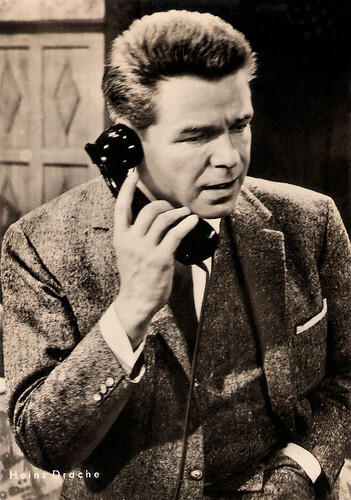
East German postcard by VEB Progress Film-Vertrieb, Berlin, no. 234/70. Heinz Drache in Der Zinker/The Squeaker (Alfred Vohrer, 1963).
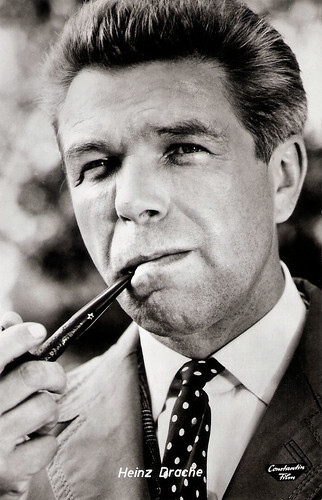
West German postcard by Kolibri - Friedrich W. Sander-Verlag, Minden/Westf., no. 2306. Photo: Rialto / Constantin Film / Winkler. Heinz Drache in Der Hexer/The Mysterious Magician (Alfred Vohrer, 1964).
Sources: Wikipedia (Dutch, German and English) and .

West German postcard by Ufa/Film-Foto, Berlin-Tempelhof, no. FK 4719 Photo: Arthur Grimm.

German postcard by Agfa, no. 525. Photo: Panorama Films. Renate Holm and Heinz Drache in Kein Auskommen mit dem Einkommen/Short of Cash (Herbert B. Fredersdorf, 1957).

East-German postcard by Progress, Berlin, no. 131/72. Photo: Suzy Kendall and Heinz Drache in Das Rätsel des silbernen Dreieck/Circus of Fear (Werner Jacobs (German version), John Llewellyn Moxey (Eglish version), 1966).
Gaining fame with Edgar Wallace Krimis
Heinz Drache was born in Essen, Germany, in 1923. Heinz did his schooling at the Alfred-Krupp-Gymnasium in Essen-Holsterhausen. He began his acting career in the theatre and acted in Nuremberg, Düsseldorf and Berlin. In Berlin, he met Gustaf Gründgens . This later brought him to Düsseldorf, where Drache was contracted for a role in Friedrich von Schiller's 'Die Räuber' (The Robbers) and in the play 'Der Schatten', which premiered in 1947. His colleagues included Käthe Gold , Marianne Hoppe , Gustav Knuth and Elisabeth Flickenschildt.
As early as the 1950s, Drache starred in numerous films and television productions. He gained fame in the 1960s in crime films based on Edgar Wallace. The first was Der Rächer/The Avenger (Karl Anton, 1960) with Ingrid van Bergen. Film critic Leonard Maltin awarded the film two and a half out of four stars, calling it "[an] Above-par shocker".
Soon followed more Wallace adaptations such as Die Tür mit den sieben Schlössern/The Door with Seven Locks (Alfred Vohrer, 1962), Der Zinker/The Squeaker (Alfred Vohrer, 1963) and Der Hexer/The Mysterious Magician (Alfred Vohrer, 1964). In 1962, he also co-starred with Albert Lieven on television in the six-part blockbuster Das Halstuch/The Scarf (Hans Quest, 1962), based on a novel by Francis Durbridge.
Because of his popularity, Drache received the Golden Bravo Otto as the most popular TV star in the 1962 readers' poll of the youth magazine BRAVO. Apart from the Krimi films he also starred in the British family film Sandy the Seal (Robert Lynn, 1965/1968) with Marianne Koch . The film was shot in South Africa in Technicolor and Techniscope II with sequences shot on Seal Island, South Africa.
He also appeared in the British/West German co-production of The Brides of Fu Manchu/Die 13 Sklavinnen des Dr. Fu Man Chu (Don Sharp, 1966). This adventure crime film was based on the fictional Chinese villain Dr. Fu Manchu, created by Sax Rohmer and played by Christopher Lee .

West German postcard by Kunst und Bild, Berlin, no. A 1068. Photo: Allianz Film. Heinz Drache in Bei dir war es immer so schön/It Was Always So Nice with You (Hans Wolff, 1954).

West German postcard by Ufa/Film-Foto, Berlin-Tempelhof, no. FK 3994. Photo: Dührkoop.

West German postcard by Kolibri-Verlag, Minden Westf., no. FK 1097. Photo: Fono / Allianz-Film. Heinz Drache in Bei dir war es immer so schön/It Was Always So Nice with You (Hans Wolff, 1954).
The German voice of Frank Sinatra
Since 1946, Heinz Drache worked intensively as a radio play actor, mainly at NWDR Cologne and WDR. He was one of the lead actors in the radio plays 'Das kurze glückliche Leben des Francis Macomber' (1951) based on Ernest Hemingway or in 'Der Untertan' (1971) based on Heinrich Mann.
Drache worked as a voice actor and dubbed such Hollywood stars as Kirk Douglas , Glenn Ford , Frank Sinatra , Sean Connery and Richard Widmark . He also worked on German versions of Apocalypse Now (Francis Ford Coppola, 1979) as the voice of Robert Duvall and The Third Man (Carol Reed, 1949) as the voice of Trevor Howard .
From 1985 to 1989, he also was inspector Bülow in six episodes of the popular Krimi series Tatort/Crime Scene. 'Don Flanello' was Drache's nickname because of his preference for tailored suits.
His last screen role was in the TV film Die Kristallprinzessin/The Crystal Princess (Rolf von Sydow, 2002) with Denise Zich and Anja Kruse. Heinz Drache was married to Rosemarie Eveline Nordmann from 1957 till his death. They had three children. His daughter Angelika, born in 1948, was from an earlier relationship with actress Edith Teichmann.
Heinz Drache passed away in 2002 at the age of 79. He died of lung cancer in a Berlin hospital after several months of illness. His grave is in the Dahlem in Veld cemetery.

West German postcard by Ufa/Film-Foto, Berlin-Tempelhof, no. FK 4055. Photo: Arca / Cinepress / Marszalek. Heinz Drache in Madeleine Tel. 13 62 11/Naked in the Night (Kurt Meisel, 1958).

East-German postcard by VEB Progress Film-Vertrieb, Berlin, no. 1705, 1962. Heinz Drache in Die Frau am dunklen Fenster/The woman at the dark window (Franz Peter Wirth, 1960).

East-German postcard by VEB Progress Film-Vertrieb, Berlin, no. 134/70.

East German postcard by VEB Progress Film-Vertrieb, Berlin, no. 234/70. Heinz Drache in Der Zinker/The Squeaker (Alfred Vohrer, 1963).

West German postcard by Kolibri - Friedrich W. Sander-Verlag, Minden/Westf., no. 2306. Photo: Rialto / Constantin Film / Winkler. Heinz Drache in Der Hexer/The Mysterious Magician (Alfred Vohrer, 1964).
Sources: Wikipedia (Dutch, German and English) and .
Published on January 25, 2023 22:00
January 24, 2023
There’s Something About Mary (1998)
There's Something About Mary (1998) is raunchy classic that doesn't take itself too seriously. The Farrelly Brothers at their funniest set some new standards for modern comedy. It's full of completely inappropriate jokes that spare nobody: male or female, handicapped or able bodied, black or white, rich or poor, straight or gay, animal or vegetable. But in the core of the film is a real heart, something impossibly optimistic and reassuring to which almost everyone can identify with. And Cameron Diaz is wonderful and charming as Mary, the girl every guy is after.
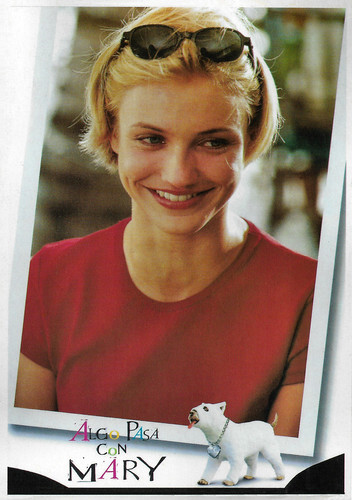
Spanish postcard by Memory Card, no. 486. Photo: 20th Century Fox. Cameron Diaz in There's Something About Mary (Bobby Farrelly, Peter Farrelly, 1998). Spanish lobby card for Algo pasa con Mary.
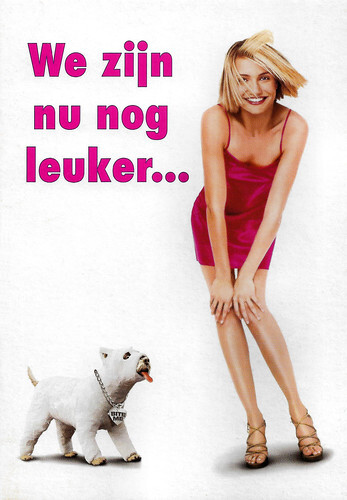
Belgian postcard by Boomerang.be. Photo: 20th Century Fox. Cameron Diaz in There's Something About Mary (Bobby Farrelly, Peter Farrelly, 1998). Caption: We zijn nu nog leuker... (We are now even more fun...).
Everybody is fixated on Mary
Sad-eyed magazine writer Ted Stroehmann (Ben Stiller) was a geek in high school, who was going to go to the prom with one of the most popular girls in school, Mary Jensen ( Cameron Diaz ). The prom date never happened, because Ted had a very unusual accident with his zipper. He never got over the girl of his high school dreams, who vanished from his life after a single date in which getting horizontal meant being carted away in an ambulance.
Thirteen years later, 29-year-old Ted realises he is still in love with Mary. On the advice of his best friend Dom Woganowski (Chris Elliott), Ted hires a private detective, the sleazy Pat Healy ( Matt Dillon ), to track her down. Pat finds her in Miami, and she's grown up beautiful. Healy discovers that she is an orthopedic surgeon living in Miami. After observing her for a few days, Healy becomes fixated on her. Pat decides he wants to date her. He stalks her, finds out everything she wants in a man, and poses as just that.
Healy gives Ted some false information to keep him away from her. Healy reports back that she's a walrus in a wheelchair and has four kids by three different men. Ted thinks maybe he should check up on her anyway, to see if he can be helpful to her, but Healy explains she's now en route to Japan as a mail-order bride.
Healy and Mary spend several weeks dating before her architect friend Tucker (Lee Evans) exposes Healy as a fraud. Tucker tells her that Healy is a suspected serial murderer. An enraged Healy follows him and discovers Tucker actually is a pizza delivery boy named Norm Phipps who also is infatuated with Mary. Years earlier, Norm intentionally injured himself in order to get close to her, hoping she would take him on as a patient. He pretends to still be disabled in order to gain Mary's sympathy and uses his friendship with her to drive away other suitors.
Ted drives to Florida to see Mary. During the drive, he picks up a hitchhiker who leaves a dead body in Ted's car. Ted is mistakenly arrested for the murder and bailed out by Dom after the police catch the real killer. Ted finds Mary and they begin dating. Things go well until an anonymous letter reveals that Ted hired Healy to find her, causing Mary to get upset and dump Ted. Enraged, Ted then confronts Healy and Norm, who deny sending the letter. Things come to a head when Dom, who is Mary's ex-boyfriend "Woogie", shows up in her apartment and admits to writing the letter. Mary previously had a restraining order against Dom after he became obsessed with her, which started again when Ted found her...
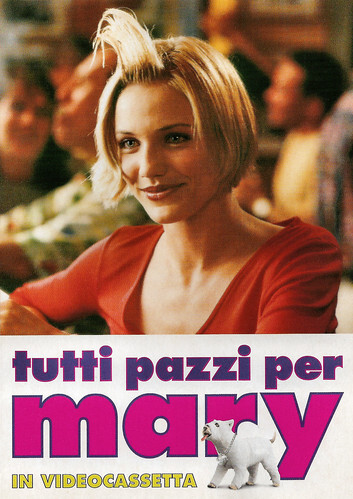
Italian postcard by Promocard, no. K 1298. Photo: 20th Century Fox. Cameron Diaz in There's Something About Mary (Bobby Farrelly, Peter Farrelly, 1998).
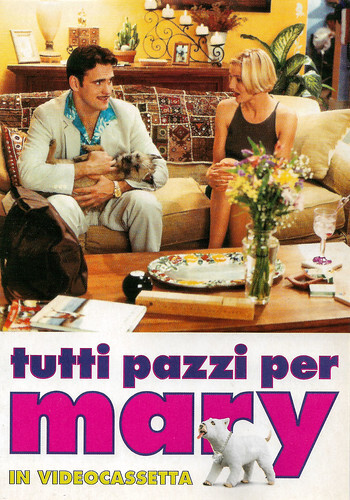
Italian postcard by Promocard, no. K 1299. Photo: 20th Century Fox. Matt Dillon and Cameron Diaz in There's Something About Mary (Bobby Farrelly, Peter Farrelly, 1998).
An unalloyed exercise in bad taste
During the 1990s, the Farelly brothers made a series of gross out comedies including Dumb and Dumber (Bobby Farrelly, Peter Farrelly, 1994), Kingpin (Bobby Farrelly, Peter Farrelly, 1996), and Me, Myself, and Irene (Bobby Farrelly, Peter Farrelly, 2000). Their There's Something About Mary (Bobby Farrelly, Peter Farrelly, 1998) has aged relatively well after 25 years. The funny gags come in a constant wave, aren't forced or out of place and expertly walk the tightrope between politically incorrect and unkind. Each joke goes somewhere, is really big and has a punchline. It is now a classic 'modern' comedy and to us the Farrelly Brothers' best film.
The characters seem real enough to be in the crazy situations they bring themselves into. Ben Stiller is great in his own way, lovable and dull at the same time. He and Cameron Diaz blend very well together. Diaz is adorable, beautiful, and a marvel to look at. You understand what the title means without ever having it explained. Her cute, perky charm clicks with all the male characters but also with audiences.
Also terrific are the supporting players. Matt Dillon is outstanding in one of his best roles. Chris Elliott is excellent as well as are Lee Evans and Harland Williams as the six-minute abs guy. All of them have the perfect comedy timing to really make all of their characters blend together well. Jonathan Richman and his drummer are especially valuable in their cameo bits that bookend the various acts in the film, with songs that manage to be as funny and affecting as the show they are built around. And then there is of course, Puffy the drugged up dog.
There are several hilarious moments in this film: the hysterical prom sequence, the three dog sequences (Puffy in a sedative coma, Puffy on speed, Puffy in a body cast), the hitchhiker sequence and its follow-up interrogation at police headquarters, the infamous hair gel scene, and old flame Woogie's sexual assault on Mary's closet. The gross out nature of the film was original at the time and was ripped off in the next decade. After this film was successfully released, there was a wave of all sorts of "gross" comedies but the majority of them missed the boat because they didn't realise that this film has a very big heart at the core. The makers of the film, Peter and Bobby Farrelly, reveal in their DVD commentary that Ted's reaction to Healy's news of Mary's condition is the key to making the film work, and they are right.
20th Century Fox released There's Something About Mary theatrically on 15 July 1998 and the film became a major box office success, grossing over $369 million worldwide against its $23 million budget. Worldwide, it became the fourth-highest-grossing film of the year. It received generally positive reviews from critics who praised its humor and Diaz's performance. Roger Ebert, the film critic of the Chicago Sun-Times: "What a blessed relief is laughter. It flies in the face of manners, values, political correctness and decorum. It exposes us for what we are, the only animal with a sense of humour. There's Something About Mary is an unalloyed exercise in bad taste, and contains five or six explosively funny sequences. OK, five explosive, one moderate. I love it when a movie takes control, sweeps away my doubts and objections, and compels me to laugh. I'm having a physical reaction, not an intellectual one. There's such freedom in laughing so loudly. I feel cleansed."
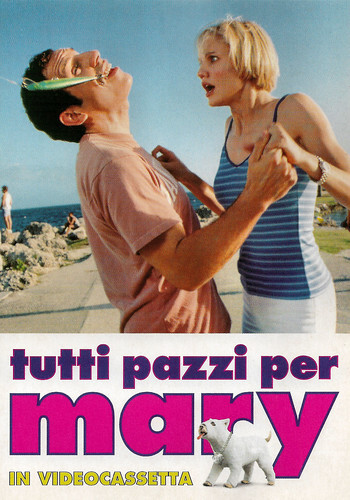
Italian postcard by Promocard, no. K 1301. Photo: 20th Century Fox. Ben Stiller and Cameron Diaz in There's Something About Mary (Bobby Farrelly, Peter Farrelly, 1998).
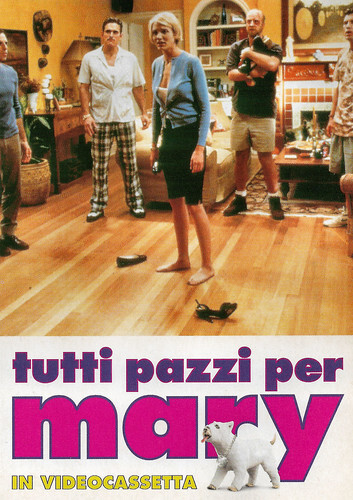
Italian postcard by Promocard, no. K 1302. Photo: 20th Century Fox. Ben Stiller, Matt Dillon , Cameron Diaz , Chris Elliott and Lee Evans in There's Something About Mary (Bobby Farrelly, Peter Farrelly, 1998).
Sources: Roger Ebert (RogerEbert.com), Wikipedia and IMDb.

Spanish postcard by Memory Card, no. 486. Photo: 20th Century Fox. Cameron Diaz in There's Something About Mary (Bobby Farrelly, Peter Farrelly, 1998). Spanish lobby card for Algo pasa con Mary.

Belgian postcard by Boomerang.be. Photo: 20th Century Fox. Cameron Diaz in There's Something About Mary (Bobby Farrelly, Peter Farrelly, 1998). Caption: We zijn nu nog leuker... (We are now even more fun...).
Everybody is fixated on Mary
Sad-eyed magazine writer Ted Stroehmann (Ben Stiller) was a geek in high school, who was going to go to the prom with one of the most popular girls in school, Mary Jensen ( Cameron Diaz ). The prom date never happened, because Ted had a very unusual accident with his zipper. He never got over the girl of his high school dreams, who vanished from his life after a single date in which getting horizontal meant being carted away in an ambulance.
Thirteen years later, 29-year-old Ted realises he is still in love with Mary. On the advice of his best friend Dom Woganowski (Chris Elliott), Ted hires a private detective, the sleazy Pat Healy ( Matt Dillon ), to track her down. Pat finds her in Miami, and she's grown up beautiful. Healy discovers that she is an orthopedic surgeon living in Miami. After observing her for a few days, Healy becomes fixated on her. Pat decides he wants to date her. He stalks her, finds out everything she wants in a man, and poses as just that.
Healy gives Ted some false information to keep him away from her. Healy reports back that she's a walrus in a wheelchair and has four kids by three different men. Ted thinks maybe he should check up on her anyway, to see if he can be helpful to her, but Healy explains she's now en route to Japan as a mail-order bride.
Healy and Mary spend several weeks dating before her architect friend Tucker (Lee Evans) exposes Healy as a fraud. Tucker tells her that Healy is a suspected serial murderer. An enraged Healy follows him and discovers Tucker actually is a pizza delivery boy named Norm Phipps who also is infatuated with Mary. Years earlier, Norm intentionally injured himself in order to get close to her, hoping she would take him on as a patient. He pretends to still be disabled in order to gain Mary's sympathy and uses his friendship with her to drive away other suitors.
Ted drives to Florida to see Mary. During the drive, he picks up a hitchhiker who leaves a dead body in Ted's car. Ted is mistakenly arrested for the murder and bailed out by Dom after the police catch the real killer. Ted finds Mary and they begin dating. Things go well until an anonymous letter reveals that Ted hired Healy to find her, causing Mary to get upset and dump Ted. Enraged, Ted then confronts Healy and Norm, who deny sending the letter. Things come to a head when Dom, who is Mary's ex-boyfriend "Woogie", shows up in her apartment and admits to writing the letter. Mary previously had a restraining order against Dom after he became obsessed with her, which started again when Ted found her...

Italian postcard by Promocard, no. K 1298. Photo: 20th Century Fox. Cameron Diaz in There's Something About Mary (Bobby Farrelly, Peter Farrelly, 1998).

Italian postcard by Promocard, no. K 1299. Photo: 20th Century Fox. Matt Dillon and Cameron Diaz in There's Something About Mary (Bobby Farrelly, Peter Farrelly, 1998).
An unalloyed exercise in bad taste
During the 1990s, the Farelly brothers made a series of gross out comedies including Dumb and Dumber (Bobby Farrelly, Peter Farrelly, 1994), Kingpin (Bobby Farrelly, Peter Farrelly, 1996), and Me, Myself, and Irene (Bobby Farrelly, Peter Farrelly, 2000). Their There's Something About Mary (Bobby Farrelly, Peter Farrelly, 1998) has aged relatively well after 25 years. The funny gags come in a constant wave, aren't forced or out of place and expertly walk the tightrope between politically incorrect and unkind. Each joke goes somewhere, is really big and has a punchline. It is now a classic 'modern' comedy and to us the Farrelly Brothers' best film.
The characters seem real enough to be in the crazy situations they bring themselves into. Ben Stiller is great in his own way, lovable and dull at the same time. He and Cameron Diaz blend very well together. Diaz is adorable, beautiful, and a marvel to look at. You understand what the title means without ever having it explained. Her cute, perky charm clicks with all the male characters but also with audiences.
Also terrific are the supporting players. Matt Dillon is outstanding in one of his best roles. Chris Elliott is excellent as well as are Lee Evans and Harland Williams as the six-minute abs guy. All of them have the perfect comedy timing to really make all of their characters blend together well. Jonathan Richman and his drummer are especially valuable in their cameo bits that bookend the various acts in the film, with songs that manage to be as funny and affecting as the show they are built around. And then there is of course, Puffy the drugged up dog.
There are several hilarious moments in this film: the hysterical prom sequence, the three dog sequences (Puffy in a sedative coma, Puffy on speed, Puffy in a body cast), the hitchhiker sequence and its follow-up interrogation at police headquarters, the infamous hair gel scene, and old flame Woogie's sexual assault on Mary's closet. The gross out nature of the film was original at the time and was ripped off in the next decade. After this film was successfully released, there was a wave of all sorts of "gross" comedies but the majority of them missed the boat because they didn't realise that this film has a very big heart at the core. The makers of the film, Peter and Bobby Farrelly, reveal in their DVD commentary that Ted's reaction to Healy's news of Mary's condition is the key to making the film work, and they are right.
20th Century Fox released There's Something About Mary theatrically on 15 July 1998 and the film became a major box office success, grossing over $369 million worldwide against its $23 million budget. Worldwide, it became the fourth-highest-grossing film of the year. It received generally positive reviews from critics who praised its humor and Diaz's performance. Roger Ebert, the film critic of the Chicago Sun-Times: "What a blessed relief is laughter. It flies in the face of manners, values, political correctness and decorum. It exposes us for what we are, the only animal with a sense of humour. There's Something About Mary is an unalloyed exercise in bad taste, and contains five or six explosively funny sequences. OK, five explosive, one moderate. I love it when a movie takes control, sweeps away my doubts and objections, and compels me to laugh. I'm having a physical reaction, not an intellectual one. There's such freedom in laughing so loudly. I feel cleansed."

Italian postcard by Promocard, no. K 1301. Photo: 20th Century Fox. Ben Stiller and Cameron Diaz in There's Something About Mary (Bobby Farrelly, Peter Farrelly, 1998).

Italian postcard by Promocard, no. K 1302. Photo: 20th Century Fox. Ben Stiller, Matt Dillon , Cameron Diaz , Chris Elliott and Lee Evans in There's Something About Mary (Bobby Farrelly, Peter Farrelly, 1998).
Sources: Roger Ebert (RogerEbert.com), Wikipedia and IMDb.
Published on January 24, 2023 22:00
January 23, 2023
Eugen Klöpfer
Eugen Klöpfer (1886-1950) was a German star character actor. In the 1920s, he appeared in numerous silent films, often in leading or heroic roles. After 1933, he identified himself strongly with National Socialism and was cast in several Nazi propaganda films. This harmed his post-war career.

German postcard by Ross Verlag, Berlin-Wilm., no. 1077/1, 1927-1928. Photo: Alex Binder.
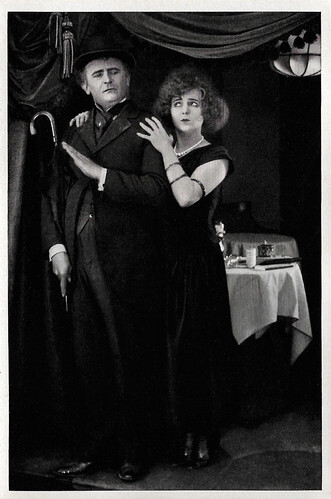
German collectors card by Ross Verlag in the series Vom Werden deutscher Filmkunst - Der Stumme Film, picture no. 103, group 43. Photo: Stern-Film. Eugen Klöpfer and Aud Egede Nissen in Die Strasse/The Street (Karl Grune, 1923).
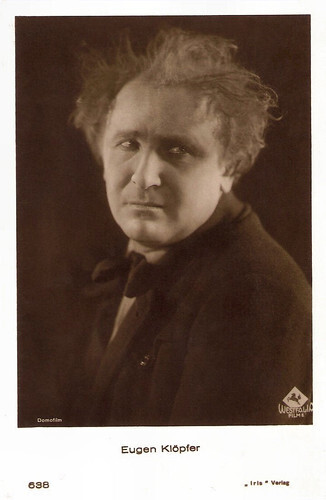
Austrian postcard by Iris Verlag, no. 638. Photo: Domofilm / Westfalia Film. Eugen Klöpfer in Elegantes Pack/The Elegant Bunch (Jaap Speyer, 1925).

German postcard by Ross Verlag, no. 148/1. Photo: K. Ewald / Oswald-Film /SF. Paul Wegener as the murderer, Eugen Klöpfer as the principal physician and Maria Koppenhöfer as Her Highness in Unheimliche Geschichten/Uncanny Stories (Richard Oswald, 1932).
One of the favourite actors of Max Reinhardt
Eugen Gottlob Klöpfer was born in 1886 in the Talheim residential area of Rauher Stich, Heilbronn. He was the youngest of eleven children of the farmer and innkeeper Karl Klöpfer and his wife Karoline, née Hörsch. Eugen attended the Realschule (secondary school) in Heilbronn. He subsequently attended the Lateinschule (Latin School) in Lauffen and then the Karlsgymnasium in Heilbronn.
Although he started an apprenticeship with a lumber business in Munich, Klöpfer soon discovered that his passion was the theatre. He joined the Theatre Association of Munich and performed at various provincial theatres. In 1905 he was cast in his first role in Landshut, afterwards playing in Ingolstadt and Biel.
In 1909 he came to the Volkstheater München (Munich People's Theatre). From 1914 to 1918, he performed in Colmar, Erfurt, Bonn and Frankfurt am Main. After the First World War, Klöpfer relocated to Berlin. There he played from 1920 to 1923 at the Deutsches Theater and soon belonged to the favourite actors of Max Reinhardt 's ensemble.
From 1925, he played on various stages in Vienna and Salzburg. Finally, he toured Europe and South America. He played the title role in Carl Zuckmayer's 1927 play 'Schinderhannes'. From 1919 he appeared in many silent films like Die Arche/The Arc (Richard Oswald, 1919) and Menschen (Martin Berger, 1920) with Bernhard Goetzke . He acted under the direction of F. W. Murnau in Der brennende Acker/The Burning Soil (Friedrich Wilhelm Murnau, 1922) with Werner Krauss and Lya de Putti .
Klöpfer often acted in leading or heroic roles. These included Boris Godunow in Der falsche Dimitri/The False Dimitri (Hans Steinhoff, 1922) and the title role in Götz von Berlichingen zubenannt mit der eisernen Hand/Götz von Berlichingen and the Iron Hand (Hubert Moest, 1925), based on the historical play by Johann Wolfgang von Goethe, set in the Holy Roman Empire.
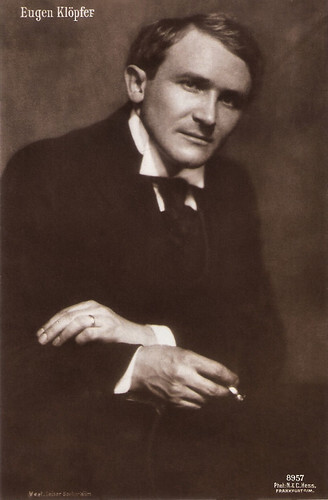
German postcard by Verlag Leiser, Berlin-Wilm., no. 8957. Photo: N. & C. Hess, Frankfurt a/M.

French postcard by Edition de la Cinématographie Française, Paris. Photo: G.P.C. Eugen Klöpfer in Der brennende Acker/Burning Soil/La terre qui flambe (Friedrich Wilhelm Murnau, 1922). Maria works in the household of Peter Rog (Eugen Klöpfer) and his father. Peter is in love with her and wants to marry her, but she instead loves his younger brother Johannes.
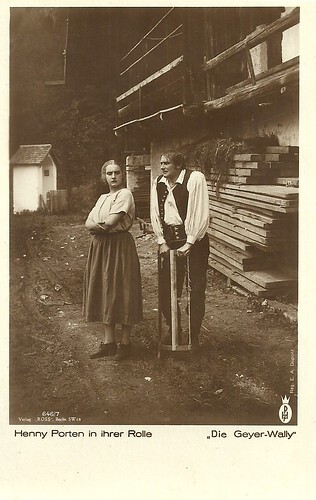
German postcard by Ross Verlag, no. 646/7, 1919-1924. Photo: HPF (Henny Porten Film). Henny Porten as Wally and Eugen Klöpfer as Vincenz in Die Geyer-Wally/Die Geier-Wally/Vulture Wally (E.A. Dupont, 1921), based on the novel by Wilhelmine von Hillern. The sets were designed by Paul Leni.
Gottbegnadet by Adolf Hitler
After the Nazi seizure of power, Eugen Klöpfer was promoted to the Presiding Board of the Reich Film Chamber, under Joseph Goebbels, and was also chairman of Goebbels' artist donation. He also appeared in the Propaganda film Flüchtlinge/Refugees (Gustav Ucicky, 1933) with Hans Albers and Käthe von Nagy . It detailed the plight of ethnic Germans, known as 'Volga Germans', in the Soviet province of Manchuria.
In 1934, Klöpfer was designated as a 'Staatsschauspieler' (actor of national importance). He was also appointed the director of the Volksbühne (People's Theatre) in Berlin. In 1935 he was appointed Vice President of the Ministry of Arts and joined the board of Ufa. In 1936 he was appointed general director of Berlin's Theater am Nollendorfplatz. In 1937, Klöpfer joined the Nazi Party.
In 1940, he played the role of Landschaftskonsulenten Sturm in Veit Harlan 's anti-Semitic Nazi propaganda film Jud Süß/Jew Süss (Veit Harlan, 1940). In August 1944, towards the end of the Second World War, Klöpfer was added by Adolf Hitler to the 'Gottbegnadeten-Liste', a list of important German artists, which exempted him from military service, including service on the home front.
After 1945, Eugen Klöpfer was banned and spent two months in prison in 1948. After a denazification trial, he was exonerated from the charge of complicity in the tragic death of Joachim Gottschalk . In 1949, he began performing again with his own ensemble in Cologne and Neustadt in der Pfalz.
Eugen Klöpfer died in 1950 in Wiesbaden, Hesse, of pneumonia. His grave is located in the South Cemetery in Wiesbaden. He was 63. Klöpfer had a long-term relationship with the actress Flockina von Platen.
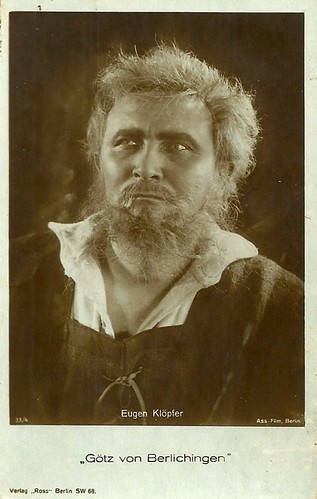
German postcard by Ross Verlag, no. 33/4. Photo: Ass-Film, Berlin. Eugen Klöpfer in Götz von Berlichingen zubenannt mit der eisernen Hand (Hubert Moest, 1925).
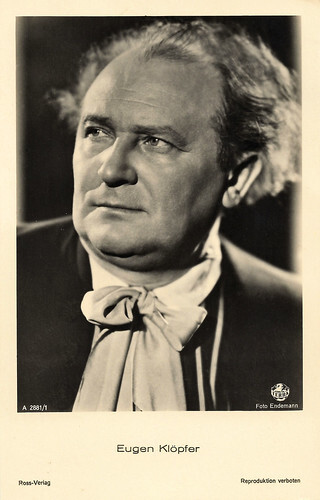
German postcard by Ross Verlag, Berlin-Wilm., no. A 2881/1, 1939-1940. Photo: Endemann / Terra. Eugen Klöpfer probably in Die fremde Frau/The Strange Woman (Roger von Norman, 1939).
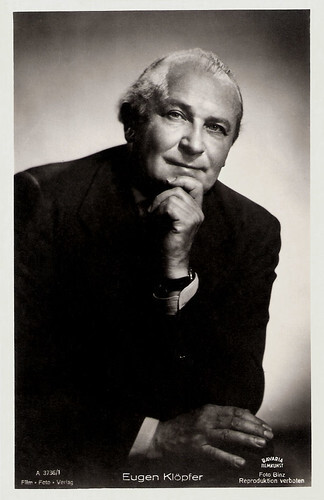
German postcard by Film-Foto-Verlag, no. A 3736/1, 1941-1944. Photo: Binz / Bavaria Filmkunst.
Sources: Wikipedia (English and German), and .

German postcard by Ross Verlag, Berlin-Wilm., no. 1077/1, 1927-1928. Photo: Alex Binder.

German collectors card by Ross Verlag in the series Vom Werden deutscher Filmkunst - Der Stumme Film, picture no. 103, group 43. Photo: Stern-Film. Eugen Klöpfer and Aud Egede Nissen in Die Strasse/The Street (Karl Grune, 1923).

Austrian postcard by Iris Verlag, no. 638. Photo: Domofilm / Westfalia Film. Eugen Klöpfer in Elegantes Pack/The Elegant Bunch (Jaap Speyer, 1925).

German postcard by Ross Verlag, no. 148/1. Photo: K. Ewald / Oswald-Film /SF. Paul Wegener as the murderer, Eugen Klöpfer as the principal physician and Maria Koppenhöfer as Her Highness in Unheimliche Geschichten/Uncanny Stories (Richard Oswald, 1932).
One of the favourite actors of Max Reinhardt
Eugen Gottlob Klöpfer was born in 1886 in the Talheim residential area of Rauher Stich, Heilbronn. He was the youngest of eleven children of the farmer and innkeeper Karl Klöpfer and his wife Karoline, née Hörsch. Eugen attended the Realschule (secondary school) in Heilbronn. He subsequently attended the Lateinschule (Latin School) in Lauffen and then the Karlsgymnasium in Heilbronn.
Although he started an apprenticeship with a lumber business in Munich, Klöpfer soon discovered that his passion was the theatre. He joined the Theatre Association of Munich and performed at various provincial theatres. In 1905 he was cast in his first role in Landshut, afterwards playing in Ingolstadt and Biel.
In 1909 he came to the Volkstheater München (Munich People's Theatre). From 1914 to 1918, he performed in Colmar, Erfurt, Bonn and Frankfurt am Main. After the First World War, Klöpfer relocated to Berlin. There he played from 1920 to 1923 at the Deutsches Theater and soon belonged to the favourite actors of Max Reinhardt 's ensemble.
From 1925, he played on various stages in Vienna and Salzburg. Finally, he toured Europe and South America. He played the title role in Carl Zuckmayer's 1927 play 'Schinderhannes'. From 1919 he appeared in many silent films like Die Arche/The Arc (Richard Oswald, 1919) and Menschen (Martin Berger, 1920) with Bernhard Goetzke . He acted under the direction of F. W. Murnau in Der brennende Acker/The Burning Soil (Friedrich Wilhelm Murnau, 1922) with Werner Krauss and Lya de Putti .
Klöpfer often acted in leading or heroic roles. These included Boris Godunow in Der falsche Dimitri/The False Dimitri (Hans Steinhoff, 1922) and the title role in Götz von Berlichingen zubenannt mit der eisernen Hand/Götz von Berlichingen and the Iron Hand (Hubert Moest, 1925), based on the historical play by Johann Wolfgang von Goethe, set in the Holy Roman Empire.

German postcard by Verlag Leiser, Berlin-Wilm., no. 8957. Photo: N. & C. Hess, Frankfurt a/M.

French postcard by Edition de la Cinématographie Française, Paris. Photo: G.P.C. Eugen Klöpfer in Der brennende Acker/Burning Soil/La terre qui flambe (Friedrich Wilhelm Murnau, 1922). Maria works in the household of Peter Rog (Eugen Klöpfer) and his father. Peter is in love with her and wants to marry her, but she instead loves his younger brother Johannes.

German postcard by Ross Verlag, no. 646/7, 1919-1924. Photo: HPF (Henny Porten Film). Henny Porten as Wally and Eugen Klöpfer as Vincenz in Die Geyer-Wally/Die Geier-Wally/Vulture Wally (E.A. Dupont, 1921), based on the novel by Wilhelmine von Hillern. The sets were designed by Paul Leni.
Gottbegnadet by Adolf Hitler
After the Nazi seizure of power, Eugen Klöpfer was promoted to the Presiding Board of the Reich Film Chamber, under Joseph Goebbels, and was also chairman of Goebbels' artist donation. He also appeared in the Propaganda film Flüchtlinge/Refugees (Gustav Ucicky, 1933) with Hans Albers and Käthe von Nagy . It detailed the plight of ethnic Germans, known as 'Volga Germans', in the Soviet province of Manchuria.
In 1934, Klöpfer was designated as a 'Staatsschauspieler' (actor of national importance). He was also appointed the director of the Volksbühne (People's Theatre) in Berlin. In 1935 he was appointed Vice President of the Ministry of Arts and joined the board of Ufa. In 1936 he was appointed general director of Berlin's Theater am Nollendorfplatz. In 1937, Klöpfer joined the Nazi Party.
In 1940, he played the role of Landschaftskonsulenten Sturm in Veit Harlan 's anti-Semitic Nazi propaganda film Jud Süß/Jew Süss (Veit Harlan, 1940). In August 1944, towards the end of the Second World War, Klöpfer was added by Adolf Hitler to the 'Gottbegnadeten-Liste', a list of important German artists, which exempted him from military service, including service on the home front.
After 1945, Eugen Klöpfer was banned and spent two months in prison in 1948. After a denazification trial, he was exonerated from the charge of complicity in the tragic death of Joachim Gottschalk . In 1949, he began performing again with his own ensemble in Cologne and Neustadt in der Pfalz.
Eugen Klöpfer died in 1950 in Wiesbaden, Hesse, of pneumonia. His grave is located in the South Cemetery in Wiesbaden. He was 63. Klöpfer had a long-term relationship with the actress Flockina von Platen.

German postcard by Ross Verlag, no. 33/4. Photo: Ass-Film, Berlin. Eugen Klöpfer in Götz von Berlichingen zubenannt mit der eisernen Hand (Hubert Moest, 1925).

German postcard by Ross Verlag, Berlin-Wilm., no. A 2881/1, 1939-1940. Photo: Endemann / Terra. Eugen Klöpfer probably in Die fremde Frau/The Strange Woman (Roger von Norman, 1939).

German postcard by Film-Foto-Verlag, no. A 3736/1, 1941-1944. Photo: Binz / Bavaria Filmkunst.
Sources: Wikipedia (English and German), and .
Published on January 23, 2023 22:00
January 22, 2023
Fritz Kampers
German actor and director Fritz Kampers (1891-1950) was a solidly-built Bavarian character actor. In films from 1913, he was much in demand during the 1920s and 1930s. Kampers was often cast as robust or comic military types, or laconic, but good-hearted rustics in mountaineering or 'Heimat' films. He appeared in more than 260 films.

German postcard by Ross Verlag, Berlin, no. 1958/1, 1927-1928. Photo: Sudfilm AG (SF). Fritz Kampers in Frühere Verhältnisse/Former conditions (Arthur Bergen, 1927).
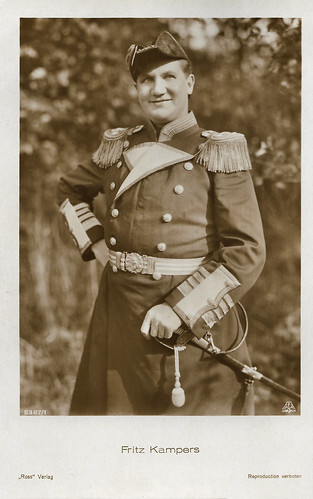
German postcard by Ross Verlag, Berlin, no. 5387/1, 1930-1931. Photo: Aafa-Film.

German postcard by Ross Verlag, no. 6993/1, 1931-1932. Photo: O. Stein.
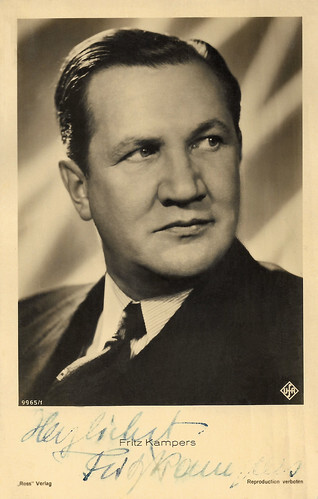
German postcard by Ross Verlag, no. 9965/1, 1935-1936. Photo: Ufa.
A cavalryman on the eastern front
Friedrich Kampers was born in München (Munich), Germany, in 1891. He was the son of a hotel owner and spent his early childhood in Garmisch-Partenkirchen. From 1901 on, Fritz attended a boarding school in Weilheim in Upper Bavaria, where he took part in student performances.
After finishing secondary school, he completed a commercial apprenticeship in a textile shop in Munich and at the same time took acting classes with Richard Stury, who presided as president of the Münchener Versuchsbühne (Munich experimental stage). After appearances there and at the Alhambratheater, he wandered through the province and finally found engagements in Alzey, Karlsruhe, Lucerne, Sondershausen, Helmstedt and Aachen.
Kampers made his film debut probably in the silent comedy Das Rosa Pantöffelchen/The Little Pink Slipper (Franz Hofer, 1913) starring Dorrit Weixler . He directed The Volkstyrann/The People's Tyrant (Fritz Kampers, 1913), in which he also played the main role opposite his famous colleague Albert Steinrück.
During the First World War, Fritz Kampers served as a cavalryman on the eastern front. After Kampers was wounded, he joined the front theatres in Warsaw and Łódź. In 1917 Kampers was committed to the Munich Volkstheater, where he got to know the director Franz Seitz, who gave him some engagements in silent films, including Verlorenes Spiel/Lost Game (Edgar Reitz, 1919).
He played in productions of the Munich Lichtspiel-Kunst (Emelka) such as Der Hauptmann-Stellvertreter/The Deputy Captain (Paul Ostermayr, 1915), and Der Rubin des Maharadscha/The Ruby of the Maharajah (Toni Attenberger, 1917). He also appeared in the historical film Der Ochsenkrieg/The War of the Oxen (Franz Osten, 1920). He also played in crime stories and Ganghofer adaptations, including Der Jäger von Fall (Franz Seitz, 1925) with Grete Reinwald.
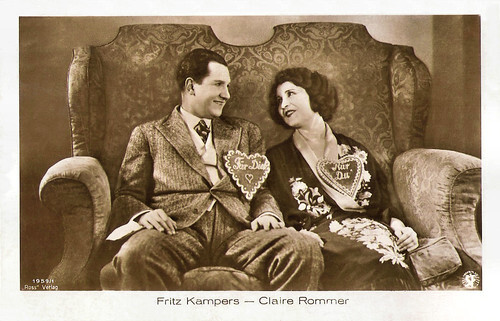
German postcard by Ross Verlag, no. 1959/1, 1927-1928. Photo: Emelka, München. Fritz Kampers and Claire Rommer in Frühere Verhältnisse/Former conditions (Arthur Bergen, 1927).
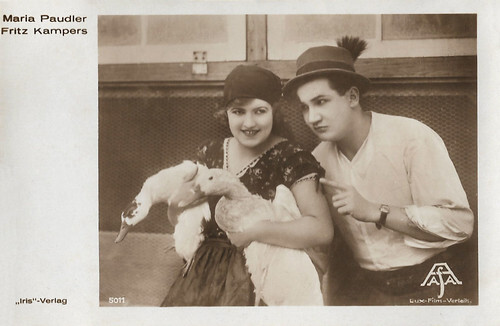
Austrian postcard by Iris-Verlag, no. 5011. Photo: AAFA Film / Lux Film-Verleih. Maria Paudler and Fritz Kampers in Heiratsfieber/Marriage Fever (Rudolf Walther-Fein, 1928).
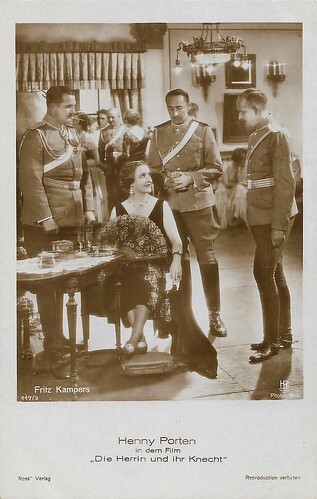
German postcard by Ross Verlag, no. 117/3. Photo: Brix / Henny Porten-Film Produktion. Henny Porten and Fritz Kampers in Die Herrin und ihr Knecht/The mistress and her servant (Richard Oswald, 1929), a drama taking place at the German-Russian border shortly before and during the First World War.

German postcard by Ross Verlag, no. 126/3. Photo: Atelier Schmoll, Berlin / Nero-Porten-Film. Henny Porten and Fritz Kampers in Kohlhiesels Töchter/Kohlhiesel's Daughters (Hans Behrendt, 1930).
Robust, blunt characters showing wit, cunning, and unexpected depth
In 1920 Fritz Kampers moved to Berlin. He played the villain in a series of twelve crime films. He appeared in another historical drama Lola Montez, die Tänzerin des Königs/Lola Montez, the King's Dancer (Willi Wolff, 1922) starring Ellen Richter . He also had a supporting part in the silent adventure film Wilhelm Tell/William Tell (Rudolf Dworsky, Rudolf Walther-Fein, 1923) starring Hans Marr, Conrad Veidt , and Erich Kaiser-Titz . The film portrays the story of the legendary Swiss national hero Wilhelm (William) Tell.
Kampers played the male lead opposite Mary Johnson in the drama Die Stimme des Herzens/The Voice of the Heart (Hanns Schwarz, 1924). Another leading followed in the silent drama Menschen am Meer/People of the Sea (Léo Lasko, 1925) also with Elisabeth Pinajeff and Fritz Rasp . He acted in Die Flucht in den Zirkus/The Circus of Life (Mario Bonnard, Guido Parish, 1926) starring Marcella Albani , and Vladimir Gajdarov .
At the same time, he performed on stages such as the Kleinen Schauspielhaus, the Lessingtheater, the German Theater and the Revue Theater Admiralspalast. Kampers also became popular as a cabaret artist. For a time he was part of the ensemble of Trude Hesterberg's political-literary cabaret 'Die Wilde Bühne'.
In the mid-1920s, Fritz Kampers started to play supporting roles as comic folk types, such as a farmer, a policeman, and a soldier - often with a Bavarian touch. Examples are Nanette macht alles/Nanette Makes Everything (Carl Boese, 1926) starring Mady Christians and Heiratsannoncen/Marriage Announcement (Fritz Kaufmann, 1926) with Max Landa and Hermann Picha .
A hit was Der Hauptmann von Köpenick/The Captain from Köpenick (Siegfried Dessauer, 1926) starring Hermann Picha . The film is based on the case of Wilhelm Voigt. Kampers co-starred with Henny Porten in the comedies Die Frau, die jeder liebt, bist du/The Woman Everyone Loves Is You (Carl Froelich, 1929) and Kohlhiesels Töchter/Kohlhiesel's Daughters (Hans Behrendt, 1930). His characters were robust and blunt on the one hand - Kampers' gestures were thrifty, his short sentences dry and almost deliberate - and showed wit, cunning, and unexpected depth on the other hand. Kampers successfully portrayed these likeable guys until the end of his film career.
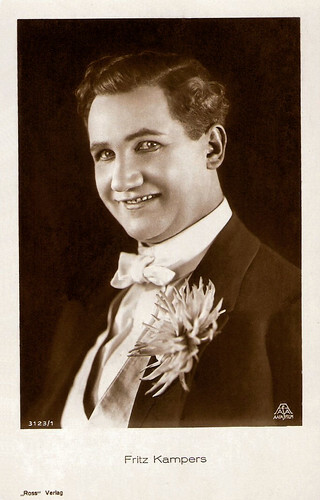
German postcard by Ross Verlag, no. 3123/1, 1928-1929. Photo: AAFA Film.
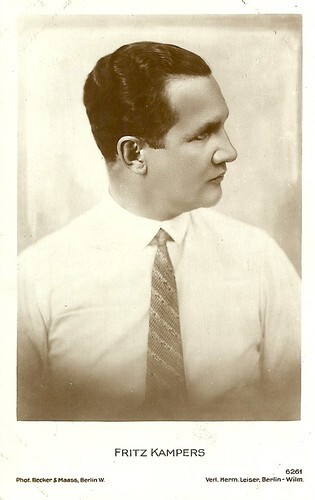
German postcard by Verlag Hermann Leiser, Berlin, no. 6261. Photo: Becker & Maass, Berlin.
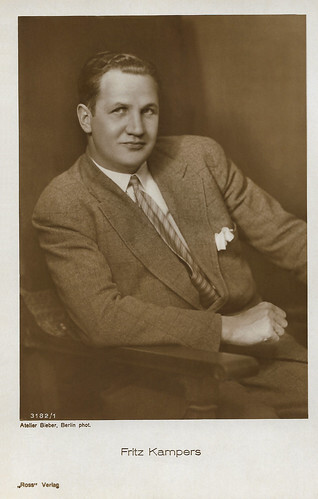
German postcard by Ross Verlag, Berlin, no. 3182/1, 1928-1929. Photo: Atelier Bieber, Berlin.
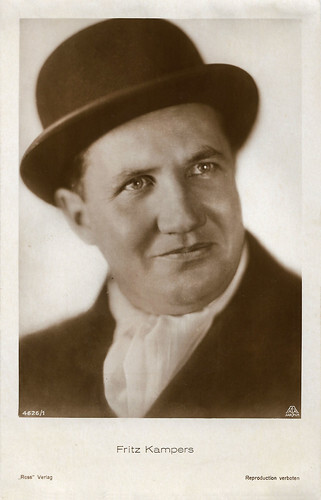
German postcard by Ross Verlag, no. 4626/1, 1929-1930. Photo: AAFA Film.
A suitable replacement
The change to the sound film fell to Fritz Kampers easily. He had great roles in two films by Georg Wilhelm Pabst, Westfront 1918/West Front 1918 (G.W. Pabst, 1930) and Kameradschaft/Comradeship (G.W. Pabst, 1931). He also had success with the musical Drei von der Stempelstelle/The Three from the Unemployment Office (Wilhelm Thiele, 1932) with Paul Kemp and Adolph Wohlbrück , and the war comedy Zwei gute Kameraden/Two Good Comrades (Max Obal, 1933) with Paul Hörbiger .
After the Nazis took the power in Germany in 1933, many film artists went abroad. The film industry was desperately looking for a suitable replacement. Kampers had occasionally directed in the period after the First World War, and he was given the opportunity to stage two of his own films: Schwank Konjunkturritter/Knights of the Economy (Fritz Kampers, 1933/34), with Weiss Ferdl and Sabine Peters, and the comedy of errors Ich sing' mich in dein Herz hinein/I sing into my heart (Fritz Kampers, 1934), with Lien Deyers and Hans Söhnker .
He also continued his acting career under the Nazi regime. In 1934 he was engaged by Eugen Klöpfer at the Volksbühne Berlin. In the cinema, Kampers played in such Nazi propaganda films as Drei Kaiserjäger/Three Emperor Hunters (1933), Die vier Musketiere/The Four Musketeers (Heinz Paul, 1934), Urlaub auf Ehrenwort/Holiday on Honor (Karl Ritter, 1938), Im Namen des Volkes/In the Name of the People (Erich Engels, 1939), Robert und Bertram/Robert and Bertram (Hans H. Zerlett, 1939), Der Feuerteufel/The Fire Devil (Luis Trenker, 1940), the drama Über alles in der Welt/Above All Else in the World (Karl Ritter, 1941) starring Paul Hartmann , and the thriller Anschlag auf Baku/Attack on Baku (Fritz Kirchhoff, 1942) starring Willy Fritsch .
Kampers was appointed Staatsschauspieler (state actor) by Joseph Goebbels in 1939, but he seems to have rejected roles in propaganda films from 1942 on. After the war, Kampers soon found employment with supporting roles in films like the crime comedy Sensation in Savoy (Eduard von Borsody, 1950) with Sybille Schmitz and the Operetta film Schwarzwaldmädel/The Black Forest Girl (Hans Deppe, 1950) with Sonja Ziemann . The film's success revived the popularity of Heimatfilm, which came to dominate the German box office over the coming decade.
Fritz Kampers passed away in 1950 in Garmisch-Partenkirchen in Bavaria at the age of 59. His resting place is in the Evangelical Cemetery in Neubeckum. Kampers was one of the most active actors in German film. Between 1918 and 1950 he has been involved in more than 260 films, that is every 17th film produced during this period.
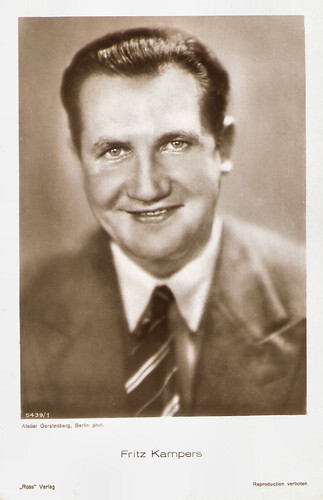
German postcard by Ross Verlag, no. 5439/1, 1930-1931. Photo: Atelier Gerstenberg.
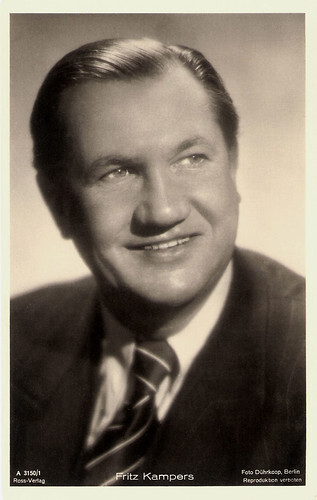
German postcard by Ross Verlag, no. A 3150/1, 1941-1944. Photo: Dührkoop, Berlin.
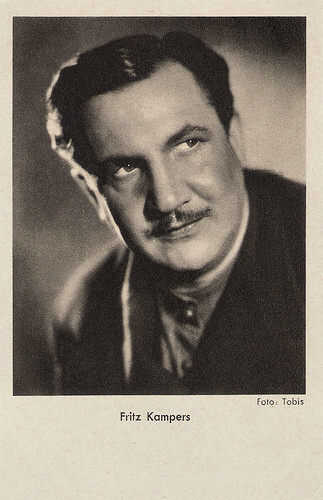
German postcard by Das Programm von Heute, Berlin. Photo: Tobis.
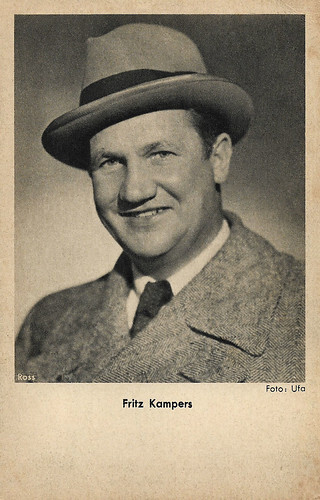
German postcard by Ross / Das Programm von Heute, Berlin. Photo: Ufa.
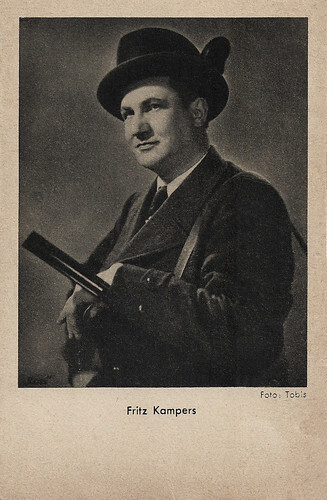
German postcard by Das Programm von Heute, Berlin. Photo: Tobis.
Sources: Hans Michael Bock (Filmportal.de - German), Wikipedia (German and English) and .

German postcard by Ross Verlag, Berlin, no. 1958/1, 1927-1928. Photo: Sudfilm AG (SF). Fritz Kampers in Frühere Verhältnisse/Former conditions (Arthur Bergen, 1927).

German postcard by Ross Verlag, Berlin, no. 5387/1, 1930-1931. Photo: Aafa-Film.

German postcard by Ross Verlag, no. 6993/1, 1931-1932. Photo: O. Stein.

German postcard by Ross Verlag, no. 9965/1, 1935-1936. Photo: Ufa.
A cavalryman on the eastern front
Friedrich Kampers was born in München (Munich), Germany, in 1891. He was the son of a hotel owner and spent his early childhood in Garmisch-Partenkirchen. From 1901 on, Fritz attended a boarding school in Weilheim in Upper Bavaria, where he took part in student performances.
After finishing secondary school, he completed a commercial apprenticeship in a textile shop in Munich and at the same time took acting classes with Richard Stury, who presided as president of the Münchener Versuchsbühne (Munich experimental stage). After appearances there and at the Alhambratheater, he wandered through the province and finally found engagements in Alzey, Karlsruhe, Lucerne, Sondershausen, Helmstedt and Aachen.
Kampers made his film debut probably in the silent comedy Das Rosa Pantöffelchen/The Little Pink Slipper (Franz Hofer, 1913) starring Dorrit Weixler . He directed The Volkstyrann/The People's Tyrant (Fritz Kampers, 1913), in which he also played the main role opposite his famous colleague Albert Steinrück.
During the First World War, Fritz Kampers served as a cavalryman on the eastern front. After Kampers was wounded, he joined the front theatres in Warsaw and Łódź. In 1917 Kampers was committed to the Munich Volkstheater, where he got to know the director Franz Seitz, who gave him some engagements in silent films, including Verlorenes Spiel/Lost Game (Edgar Reitz, 1919).
He played in productions of the Munich Lichtspiel-Kunst (Emelka) such as Der Hauptmann-Stellvertreter/The Deputy Captain (Paul Ostermayr, 1915), and Der Rubin des Maharadscha/The Ruby of the Maharajah (Toni Attenberger, 1917). He also appeared in the historical film Der Ochsenkrieg/The War of the Oxen (Franz Osten, 1920). He also played in crime stories and Ganghofer adaptations, including Der Jäger von Fall (Franz Seitz, 1925) with Grete Reinwald.

German postcard by Ross Verlag, no. 1959/1, 1927-1928. Photo: Emelka, München. Fritz Kampers and Claire Rommer in Frühere Verhältnisse/Former conditions (Arthur Bergen, 1927).

Austrian postcard by Iris-Verlag, no. 5011. Photo: AAFA Film / Lux Film-Verleih. Maria Paudler and Fritz Kampers in Heiratsfieber/Marriage Fever (Rudolf Walther-Fein, 1928).

German postcard by Ross Verlag, no. 117/3. Photo: Brix / Henny Porten-Film Produktion. Henny Porten and Fritz Kampers in Die Herrin und ihr Knecht/The mistress and her servant (Richard Oswald, 1929), a drama taking place at the German-Russian border shortly before and during the First World War.

German postcard by Ross Verlag, no. 126/3. Photo: Atelier Schmoll, Berlin / Nero-Porten-Film. Henny Porten and Fritz Kampers in Kohlhiesels Töchter/Kohlhiesel's Daughters (Hans Behrendt, 1930).
Robust, blunt characters showing wit, cunning, and unexpected depth
In 1920 Fritz Kampers moved to Berlin. He played the villain in a series of twelve crime films. He appeared in another historical drama Lola Montez, die Tänzerin des Königs/Lola Montez, the King's Dancer (Willi Wolff, 1922) starring Ellen Richter . He also had a supporting part in the silent adventure film Wilhelm Tell/William Tell (Rudolf Dworsky, Rudolf Walther-Fein, 1923) starring Hans Marr, Conrad Veidt , and Erich Kaiser-Titz . The film portrays the story of the legendary Swiss national hero Wilhelm (William) Tell.
Kampers played the male lead opposite Mary Johnson in the drama Die Stimme des Herzens/The Voice of the Heart (Hanns Schwarz, 1924). Another leading followed in the silent drama Menschen am Meer/People of the Sea (Léo Lasko, 1925) also with Elisabeth Pinajeff and Fritz Rasp . He acted in Die Flucht in den Zirkus/The Circus of Life (Mario Bonnard, Guido Parish, 1926) starring Marcella Albani , and Vladimir Gajdarov .
At the same time, he performed on stages such as the Kleinen Schauspielhaus, the Lessingtheater, the German Theater and the Revue Theater Admiralspalast. Kampers also became popular as a cabaret artist. For a time he was part of the ensemble of Trude Hesterberg's political-literary cabaret 'Die Wilde Bühne'.
In the mid-1920s, Fritz Kampers started to play supporting roles as comic folk types, such as a farmer, a policeman, and a soldier - often with a Bavarian touch. Examples are Nanette macht alles/Nanette Makes Everything (Carl Boese, 1926) starring Mady Christians and Heiratsannoncen/Marriage Announcement (Fritz Kaufmann, 1926) with Max Landa and Hermann Picha .
A hit was Der Hauptmann von Köpenick/The Captain from Köpenick (Siegfried Dessauer, 1926) starring Hermann Picha . The film is based on the case of Wilhelm Voigt. Kampers co-starred with Henny Porten in the comedies Die Frau, die jeder liebt, bist du/The Woman Everyone Loves Is You (Carl Froelich, 1929) and Kohlhiesels Töchter/Kohlhiesel's Daughters (Hans Behrendt, 1930). His characters were robust and blunt on the one hand - Kampers' gestures were thrifty, his short sentences dry and almost deliberate - and showed wit, cunning, and unexpected depth on the other hand. Kampers successfully portrayed these likeable guys until the end of his film career.

German postcard by Ross Verlag, no. 3123/1, 1928-1929. Photo: AAFA Film.

German postcard by Verlag Hermann Leiser, Berlin, no. 6261. Photo: Becker & Maass, Berlin.

German postcard by Ross Verlag, Berlin, no. 3182/1, 1928-1929. Photo: Atelier Bieber, Berlin.

German postcard by Ross Verlag, no. 4626/1, 1929-1930. Photo: AAFA Film.
A suitable replacement
The change to the sound film fell to Fritz Kampers easily. He had great roles in two films by Georg Wilhelm Pabst, Westfront 1918/West Front 1918 (G.W. Pabst, 1930) and Kameradschaft/Comradeship (G.W. Pabst, 1931). He also had success with the musical Drei von der Stempelstelle/The Three from the Unemployment Office (Wilhelm Thiele, 1932) with Paul Kemp and Adolph Wohlbrück , and the war comedy Zwei gute Kameraden/Two Good Comrades (Max Obal, 1933) with Paul Hörbiger .
After the Nazis took the power in Germany in 1933, many film artists went abroad. The film industry was desperately looking for a suitable replacement. Kampers had occasionally directed in the period after the First World War, and he was given the opportunity to stage two of his own films: Schwank Konjunkturritter/Knights of the Economy (Fritz Kampers, 1933/34), with Weiss Ferdl and Sabine Peters, and the comedy of errors Ich sing' mich in dein Herz hinein/I sing into my heart (Fritz Kampers, 1934), with Lien Deyers and Hans Söhnker .
He also continued his acting career under the Nazi regime. In 1934 he was engaged by Eugen Klöpfer at the Volksbühne Berlin. In the cinema, Kampers played in such Nazi propaganda films as Drei Kaiserjäger/Three Emperor Hunters (1933), Die vier Musketiere/The Four Musketeers (Heinz Paul, 1934), Urlaub auf Ehrenwort/Holiday on Honor (Karl Ritter, 1938), Im Namen des Volkes/In the Name of the People (Erich Engels, 1939), Robert und Bertram/Robert and Bertram (Hans H. Zerlett, 1939), Der Feuerteufel/The Fire Devil (Luis Trenker, 1940), the drama Über alles in der Welt/Above All Else in the World (Karl Ritter, 1941) starring Paul Hartmann , and the thriller Anschlag auf Baku/Attack on Baku (Fritz Kirchhoff, 1942) starring Willy Fritsch .
Kampers was appointed Staatsschauspieler (state actor) by Joseph Goebbels in 1939, but he seems to have rejected roles in propaganda films from 1942 on. After the war, Kampers soon found employment with supporting roles in films like the crime comedy Sensation in Savoy (Eduard von Borsody, 1950) with Sybille Schmitz and the Operetta film Schwarzwaldmädel/The Black Forest Girl (Hans Deppe, 1950) with Sonja Ziemann . The film's success revived the popularity of Heimatfilm, which came to dominate the German box office over the coming decade.
Fritz Kampers passed away in 1950 in Garmisch-Partenkirchen in Bavaria at the age of 59. His resting place is in the Evangelical Cemetery in Neubeckum. Kampers was one of the most active actors in German film. Between 1918 and 1950 he has been involved in more than 260 films, that is every 17th film produced during this period.

German postcard by Ross Verlag, no. 5439/1, 1930-1931. Photo: Atelier Gerstenberg.

German postcard by Ross Verlag, no. A 3150/1, 1941-1944. Photo: Dührkoop, Berlin.

German postcard by Das Programm von Heute, Berlin. Photo: Tobis.

German postcard by Ross / Das Programm von Heute, Berlin. Photo: Ufa.

German postcard by Das Programm von Heute, Berlin. Photo: Tobis.
Sources: Hans Michael Bock (Filmportal.de - German), Wikipedia (German and English) and .
Published on January 22, 2023 22:00
January 21, 2023
Erik Schumann
Erik Schumann (1925-2007) was an intense, dark-haired leading actor of post-war German cinema, who often specialised in playing introspective or psychologically damaged characters. He appeared regularly on stage in Berlin, Frankfurt, Stuttgart and Munich from 1943. He was at the peak of his popularity, both in films and on television, during the 1950s and 1960s. A prolific voice-over artist, Schumann also provided the German voice for stars like Peter O'Toole, Marcello Mastroianni, Christopher Lee and Roger Moore.
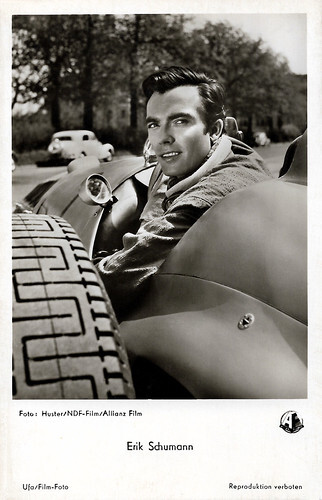
West German postcard by Ufa/Film-Foto, Berlin-Tempelhof, no. FK 1705. Photo: Huster / NDF-Film / Allianz-Film. Erik Schumann in Griff nach den Sternen/Reaching for the Stars (Carl-Heinz Schroth, 1955).
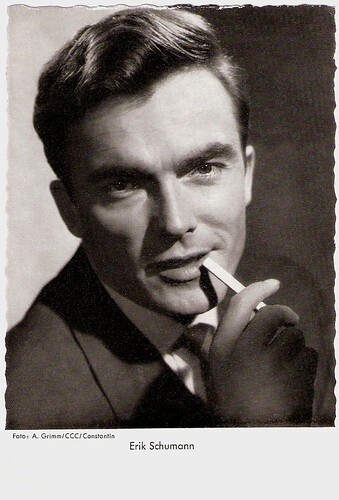
West-German collectors card. Photo: Arthur Grimm / CCC / Constantin.
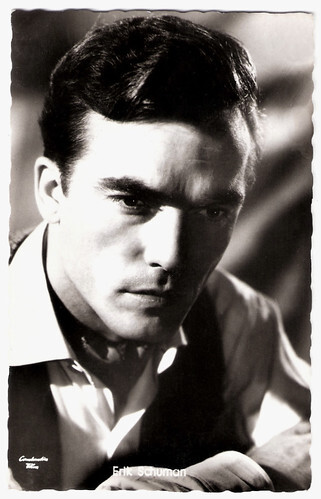
West German postcard by Kolibri-Verlag, Minden/Westf., no. 2228. Photo: CCC / Constantin Film / Arthur Grimm. Erik Schumann in Studentin Helene Wilfüer/Student Helene Wilfüer (Rudolf Jugert, 1956).
Young Germans at a Hitler Youth camp
Erich Heinz Schumann was born in 1925 in Grechwitz (now Grimma-Grechwitz), Germany.
In addition to his musical training in piano and trombone, he took acting lessons at the Dresden Conservatory. Afterwards, he got his first engagements at the Staatstheater Dresden, at the Berlin Schloßparktheater as well as in Frankfurt am Main, in Stuttgart and in Munich from 1943.
As a youth, he appeared in the Nazi Propaganda film Himmelhunde/Sky dogs (Roger von Norman, 1942) about young Germans at a Hitler Youth camp who engage in a program to learn how to build and fly gliders. His first film role as an adult was as a corps student in the DEFA film Semmelweis - Retter der Mütter/Dr. Semmelweis (Georg C. Klaren, 1950) starring Karl Paryla.
In 1954 he played his first role in a Federal Republic film, in Konsul Strotthoff/Melody Beyond Love (Erich Engel, 1954), opposite Willy Birgel and Inge Egger . His breakthrough came with the East-West love drama Himmel ohne Sterne/Sky Without Stars (Helmut Käutner, 1955).
From then on he appeared in various roles alongside Heinz Erhardt, Bernhard Wicki , Hansjörg Felmy , Ulla Jacobsson, Sonja Ziemann and Gunnar Möller among others. In 1960 he appeared in Fabrik der Offiziere/Operation Terror (Frank Wisbar, 1960) alongside Helmut Griem and Horst Frank.
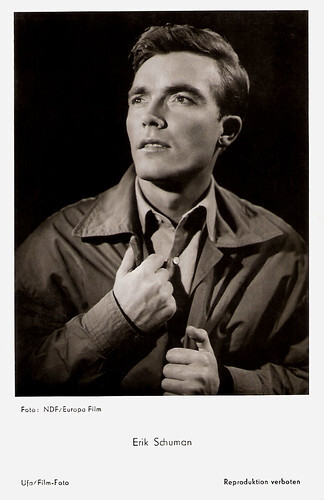
West-German postcard by Ufa/Film-Foto, Berlin-Temp[elhof, no. FK 1920. Photo: NDR / Europa Film. Erik Schumann in Himmel ohne Sterne/Sky Without Stars (Helmut Käutner, 1955).
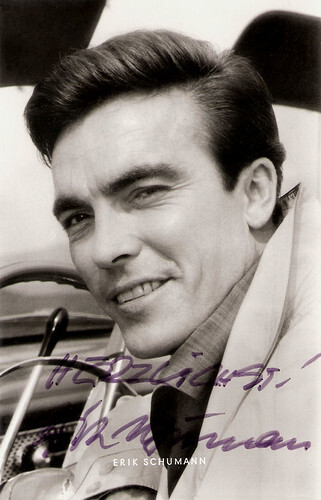
West German postcard by Kunst und Bild, Berlin. Photo: Brigitte Dittner.
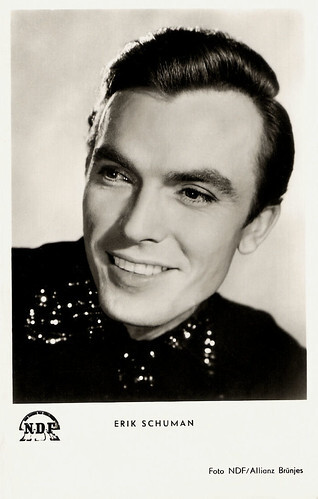
West German postcard by Kunst und Bild, Berlin, no. A 1384. Photo: NJF / Allianz / Brünjes. Erik Schumann in Griff nach den Sternen/Reaching for the Stars (Carl-Heinz Schroth, 1955).
The voice of Buck the dog
Erik Schumann began dubbing in 1949 and till 2004 he lent his voice to 600 films and TV productions. He dubbed actors such as Tony Curtis in Manche mögen's heiß/Some Like it Hot (Billy Wilder, 1959), Cary Grant in Leopards Don't Kiss/Bringing Up Baby (Howard Hawks, 1938), and Jack Nicholson in Die Ehre der Prizzis/Prizzi's Honor (John Huston, 1985).
His distinctive voice was also in great demand for radio drama productions, and in 1968 he voiced Dr. Watson in six Sherlock Holmes stories for Bayerischer Rundfunk. Erik Schumann was also heard in roles in numerous television series, such as for Martin Landau in the first dubbing phase of Kobra, übernehmen Sie/Mission: Impossible (1967-1973), for Pernell Roberts in Hawkins (1973-1974), or for Jack Klugman in Du schon wieder/You again? (1986).
On the series Eine schrecklich nette Familie/Married... with Children (1987-1997), he dubbed and was heard as the voice of Buck the dog. In the Brazilian telenovela Sinhá Moça - Die Tochter des Sklavenhalters/Sinha Moça (1986-1987), he lent his voice to the Latin-American star Rubens de Falco as Colonel Ferreira. In 1987, he was the first Jedermann (Everyman) at the Berlin Jedermann Festival. In 2000, Schumann dubbed the role of the gold digger Stinky Pete, originally voiced by Kelsey Grammer, in the computer-animated film Toy Story 2 (John Lasseter, 1999) produced by Pixar.
He also appeared in numerous television productions and made guest appearances in the popular Krimi series Der Kommissar/The Commissioner (1969-1975) and Derrick (1983). His work as an investigator in the television series Tatort/Crime Scene was limited to one episode in 1981. In the 1980s he appeared in the cinema in two Fassbinder classics, Lili Marleen (Rainer Werner Fassbinder, 1981) with Hanna Schygulla and Die Sehnsucht der Veronika Voss/Veronika Voss (Rainer Werner Fassbinder, 1982) with Rosel Zech.
He also appeared in the Italian film L'inchiesta/The Inquiry (Damiano Damiani, 1987) starring Keith Carradine and Harvey Keitel. His last role was in the crime film Mörderischer Plan/Murderous Plan (Raoul W. Heimrich, 2003). Erik Schumann was married twice (in his first marriage to the actress Erika Dannhoff) and had two children. He last lived in Straßlach near Munich, where he succumbed to cancer in 2007 at the age of 82 and was buried there.
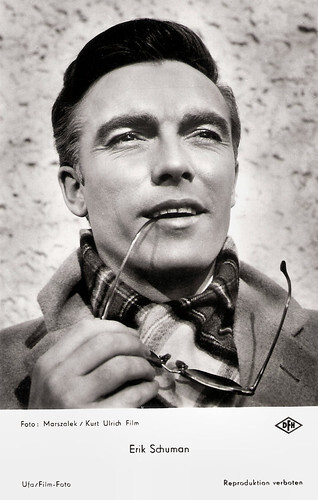
West-German postcard by Ufa/Film-Foto, Berlin-Tempelhof, no. FK 4491. Photo: Marszalek / Kurt Ulrich-Film Deutschen Film Hansa. Erik Schumann in So angelt man keinen Mann/That's No Way to Land a Man (Hans Deppe, 1959).
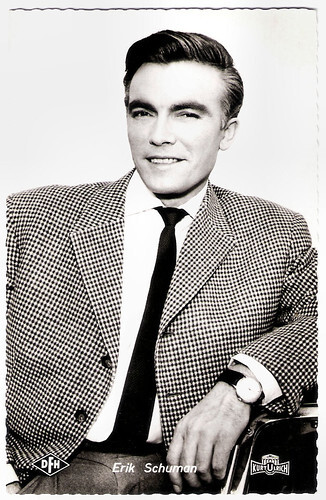
West German postcard by Kolibri-Verlag G.m.b.H., Minden/Westf, no. 645. Photo: Marszalek / Kurt Ulrich-Film / Deutschen Film Hansa. Erik Schumann in So angelt man keinen Mann/That's No Way to Land a Man (Hans Deppe, 1959).
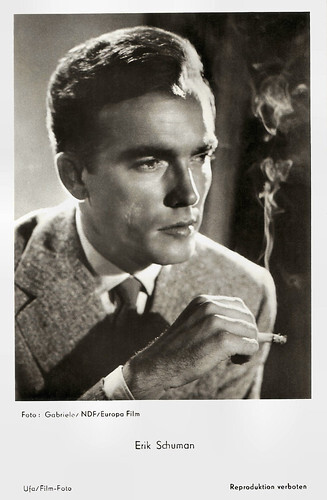
WestGerman postcard by Ufa/Film-Foto, no. FK 1918. Photo: Gabriele / NDF / Europa-Film.
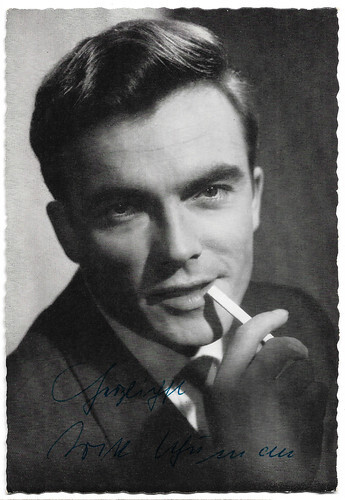
West German postcard by WS-Druck, Wanne-Eickel, no. 118. Photo: Arthur Grimm / CCC / Constantin.
Sources: Deutsche Synchron-kartei (German), Wikipedia (English and German) and .

West German postcard by Ufa/Film-Foto, Berlin-Tempelhof, no. FK 1705. Photo: Huster / NDF-Film / Allianz-Film. Erik Schumann in Griff nach den Sternen/Reaching for the Stars (Carl-Heinz Schroth, 1955).

West-German collectors card. Photo: Arthur Grimm / CCC / Constantin.

West German postcard by Kolibri-Verlag, Minden/Westf., no. 2228. Photo: CCC / Constantin Film / Arthur Grimm. Erik Schumann in Studentin Helene Wilfüer/Student Helene Wilfüer (Rudolf Jugert, 1956).
Young Germans at a Hitler Youth camp
Erich Heinz Schumann was born in 1925 in Grechwitz (now Grimma-Grechwitz), Germany.
In addition to his musical training in piano and trombone, he took acting lessons at the Dresden Conservatory. Afterwards, he got his first engagements at the Staatstheater Dresden, at the Berlin Schloßparktheater as well as in Frankfurt am Main, in Stuttgart and in Munich from 1943.
As a youth, he appeared in the Nazi Propaganda film Himmelhunde/Sky dogs (Roger von Norman, 1942) about young Germans at a Hitler Youth camp who engage in a program to learn how to build and fly gliders. His first film role as an adult was as a corps student in the DEFA film Semmelweis - Retter der Mütter/Dr. Semmelweis (Georg C. Klaren, 1950) starring Karl Paryla.
In 1954 he played his first role in a Federal Republic film, in Konsul Strotthoff/Melody Beyond Love (Erich Engel, 1954), opposite Willy Birgel and Inge Egger . His breakthrough came with the East-West love drama Himmel ohne Sterne/Sky Without Stars (Helmut Käutner, 1955).
From then on he appeared in various roles alongside Heinz Erhardt, Bernhard Wicki , Hansjörg Felmy , Ulla Jacobsson, Sonja Ziemann and Gunnar Möller among others. In 1960 he appeared in Fabrik der Offiziere/Operation Terror (Frank Wisbar, 1960) alongside Helmut Griem and Horst Frank.

West-German postcard by Ufa/Film-Foto, Berlin-Temp[elhof, no. FK 1920. Photo: NDR / Europa Film. Erik Schumann in Himmel ohne Sterne/Sky Without Stars (Helmut Käutner, 1955).

West German postcard by Kunst und Bild, Berlin. Photo: Brigitte Dittner.

West German postcard by Kunst und Bild, Berlin, no. A 1384. Photo: NJF / Allianz / Brünjes. Erik Schumann in Griff nach den Sternen/Reaching for the Stars (Carl-Heinz Schroth, 1955).
The voice of Buck the dog
Erik Schumann began dubbing in 1949 and till 2004 he lent his voice to 600 films and TV productions. He dubbed actors such as Tony Curtis in Manche mögen's heiß/Some Like it Hot (Billy Wilder, 1959), Cary Grant in Leopards Don't Kiss/Bringing Up Baby (Howard Hawks, 1938), and Jack Nicholson in Die Ehre der Prizzis/Prizzi's Honor (John Huston, 1985).
His distinctive voice was also in great demand for radio drama productions, and in 1968 he voiced Dr. Watson in six Sherlock Holmes stories for Bayerischer Rundfunk. Erik Schumann was also heard in roles in numerous television series, such as for Martin Landau in the first dubbing phase of Kobra, übernehmen Sie/Mission: Impossible (1967-1973), for Pernell Roberts in Hawkins (1973-1974), or for Jack Klugman in Du schon wieder/You again? (1986).
On the series Eine schrecklich nette Familie/Married... with Children (1987-1997), he dubbed and was heard as the voice of Buck the dog. In the Brazilian telenovela Sinhá Moça - Die Tochter des Sklavenhalters/Sinha Moça (1986-1987), he lent his voice to the Latin-American star Rubens de Falco as Colonel Ferreira. In 1987, he was the first Jedermann (Everyman) at the Berlin Jedermann Festival. In 2000, Schumann dubbed the role of the gold digger Stinky Pete, originally voiced by Kelsey Grammer, in the computer-animated film Toy Story 2 (John Lasseter, 1999) produced by Pixar.
He also appeared in numerous television productions and made guest appearances in the popular Krimi series Der Kommissar/The Commissioner (1969-1975) and Derrick (1983). His work as an investigator in the television series Tatort/Crime Scene was limited to one episode in 1981. In the 1980s he appeared in the cinema in two Fassbinder classics, Lili Marleen (Rainer Werner Fassbinder, 1981) with Hanna Schygulla and Die Sehnsucht der Veronika Voss/Veronika Voss (Rainer Werner Fassbinder, 1982) with Rosel Zech.
He also appeared in the Italian film L'inchiesta/The Inquiry (Damiano Damiani, 1987) starring Keith Carradine and Harvey Keitel. His last role was in the crime film Mörderischer Plan/Murderous Plan (Raoul W. Heimrich, 2003). Erik Schumann was married twice (in his first marriage to the actress Erika Dannhoff) and had two children. He last lived in Straßlach near Munich, where he succumbed to cancer in 2007 at the age of 82 and was buried there.

West-German postcard by Ufa/Film-Foto, Berlin-Tempelhof, no. FK 4491. Photo: Marszalek / Kurt Ulrich-Film Deutschen Film Hansa. Erik Schumann in So angelt man keinen Mann/That's No Way to Land a Man (Hans Deppe, 1959).

West German postcard by Kolibri-Verlag G.m.b.H., Minden/Westf, no. 645. Photo: Marszalek / Kurt Ulrich-Film / Deutschen Film Hansa. Erik Schumann in So angelt man keinen Mann/That's No Way to Land a Man (Hans Deppe, 1959).

WestGerman postcard by Ufa/Film-Foto, no. FK 1918. Photo: Gabriele / NDF / Europa-Film.

West German postcard by WS-Druck, Wanne-Eickel, no. 118. Photo: Arthur Grimm / CCC / Constantin.
Sources: Deutsche Synchron-kartei (German), Wikipedia (English and German) and .
Published on January 21, 2023 22:00
January 20, 2023
Photo by Fontana
Fontana in Rome portrayed many divas an other stars of the Italian silent cinema. These portraits were reproduced for a series of popular postcards in sepia and later in black and white by Edizione A. Traldi in Milan. Sadly, we could not find more information on the photographer and his/her studio.
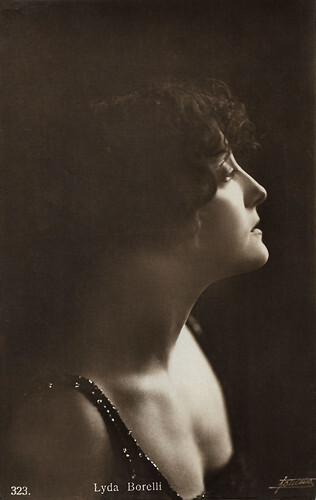
Italian postcard by Ed. A. Traldi, Milano, no. 323. Photo: Fontana.
Considering her profile, it is not hard to imagine why critics and artists of the early 20th century compared Lyda Borelli (1887-1959) to the heroines of Aubrey Beardsley.
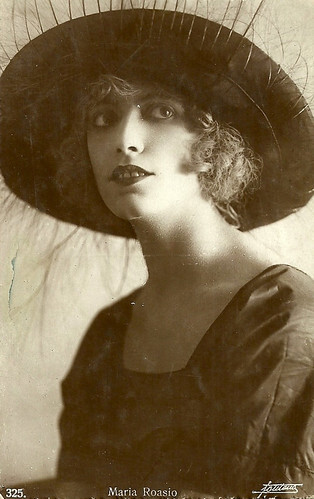
Italian postcard, no. 325. Photo: Fontana.
Maria Roasio (?-?) was an Italian actress, who acted in the late 1910s and early 1920s in Italian silent cinema, in particular at Ambrosio.
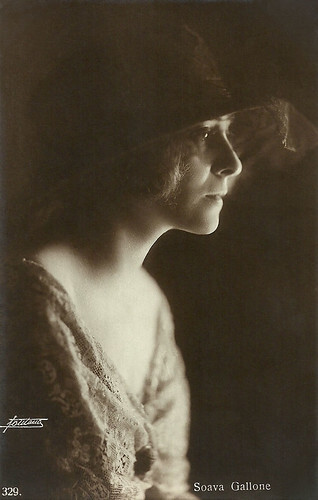
Italian postcard by Ed. A. Traldi, Milano, no. 329. Photo: Fontana, Roma.
Polish actress Soava Gallone (1880-1957) was one of the divas of Italian silent cinema.
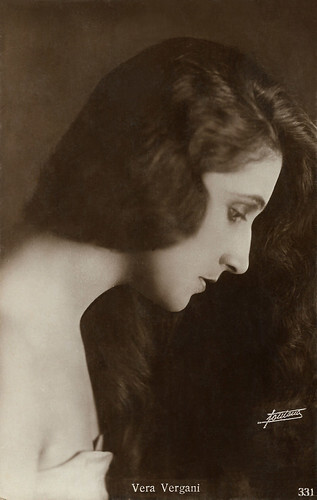
Italian postcard by Ed. A. Traldi, Milano, no. 331. Photo: Fontana.
Vera Vergani (1894 –1989) was an Italian stage and film actress. She not only performed in the first stagings of Luigi Pirandello’s plays but in 1916-1921 she also knew a career as an actress in Italian silent cinema.
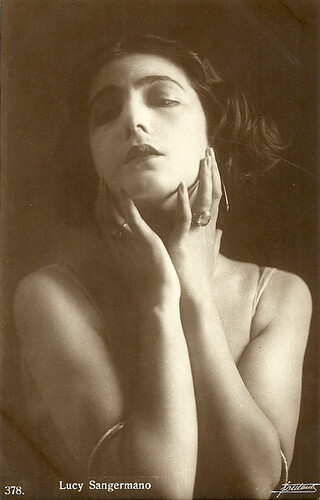
Italian postcard, no. 378. Photo: Fontana.
Lucy di San Germano aka Lucy Sangermano (1898-?) was an Italian silent film actress who peaked in the late 1910s and early 1920s.
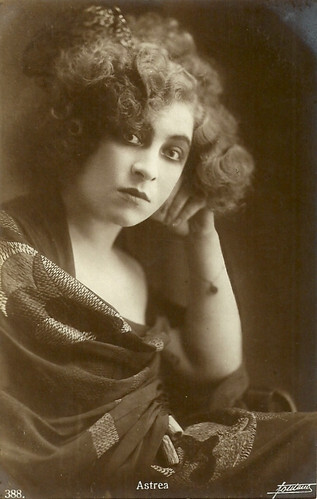
Italian postcard, no. 388. Photo: Fontana.
Astrea (?-?) was the enigmatic female ‘forzuto’ of Italian silent cinema.
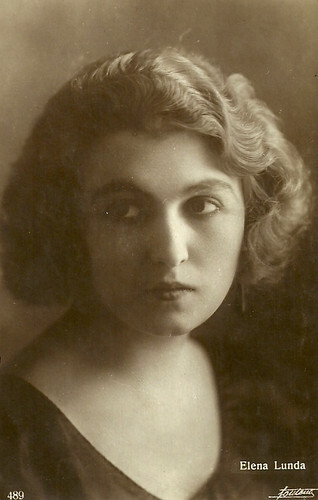
Italian postcard by Ed. A. Traldi, Milano, no. 489. Photo: Fontana.
Elena Lunda (1901-1947) was an Italian actress who acted in some 35 Italian silent films, as well as German silent films. She was briefly married to actor Alfredo Bertone.
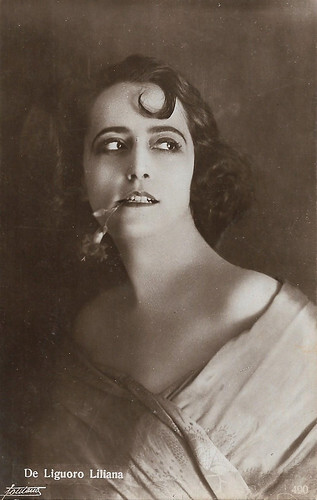
Italian postcard by Ed. A. Traldi, Milano, no. 490. Photo: Fontana.
Liliana De Liguoro is known to have made just one film, Il racconto di carnevale (Max Galotti, 1921), produced by Ambra Film/ UCI. It is one of many films produced and scripted by Lucio D'Ambra and directed by one of his collaborators. De Liguoro looks like the spitting image of the better-known Rina De Liguoro , so she may have been a sister, a lookalike, or just Rina herself.
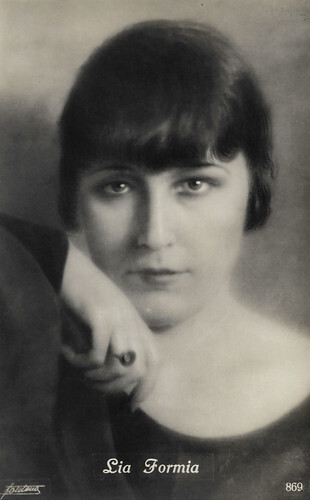
Italian postcard by Ed. A. Traldi, Milano, no. 869. Photo: Fontana.
Italian actress Lia Formia appeared in 20 silent films between 1918 and 1925. For years she was the leading actress of director Lucio D'Ambra.
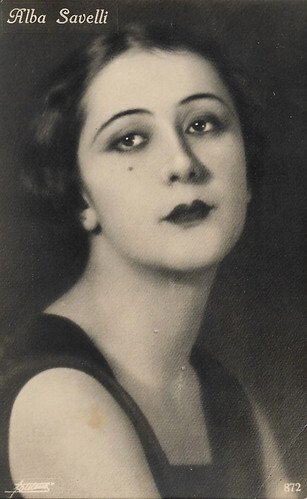
Italian postcard, no. 872. Photo: Fontana.
Italian actress Alba Savelli (?-?) played in a handful of films between the mid-1920s and the end of the decade.
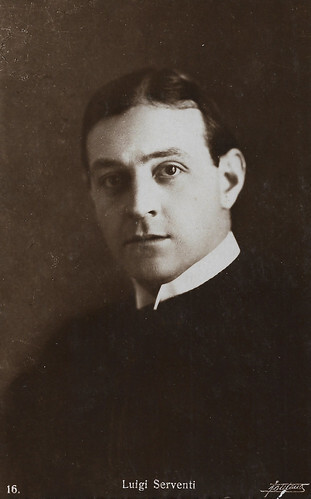
Italian postcard, no. 16. Photo: Fontana.
Luigi Serventi , aka Gigi Serventi (1885-1976), was a male star of Italian silent cinema, often cast with Italian divas such as Pina Menichelli. After his Italian career, he continued in Germany and Czechoslovakia in the 1920s.
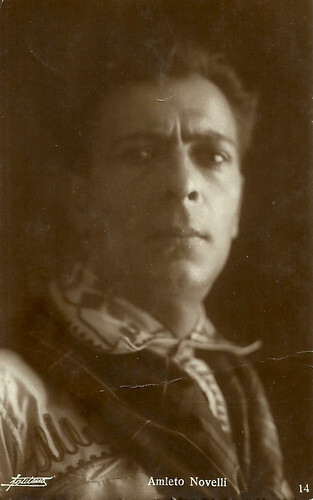
Italian postcard, no. 14. Photo: Fontana. In the early 1910s, Amleto Novelli played in the early Western Sulla via dell'oro (1913) and the rural La rupe di Malconsiglio (1913). Novelli's outfit in this photo may well refer to one of these films.
Amleto Novelli (1885-1924) was a star actor in the Italian silent cinema. He appeared in many biblical epics and starred with all the divas of the Italian film. During the shooting of a film, he suddenly died, only 38.
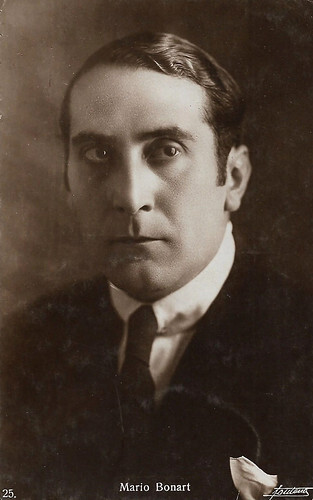
Italian postcard, no. 25. Photo: Fontana, Rome. Mario Bonnard 's name is misspelt as Bonart.
Mario Bonnard aka Mario Bonard (1889-1965) was an Italian actor and director, whose career spanned from 1909 to the early 1960s.
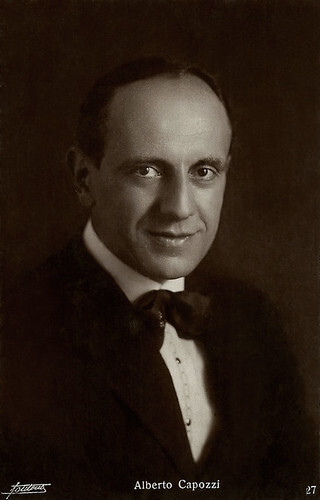
Italian postcard by Ed. A. Traldi, Milano, no. 27. Photo: Fontana.
Alberto Capozzi (1886-1945) was an Italian film and stage actor who had an enormous career in Italian cinema in the 1910s and early 1920s. Afterwards, he pursued a career abroad in Austria and as a sound dubber in France. He returned to film acting in Italian cinema in the early 1940s.

Italian postcard by Ed. A. Traldi, Milano, no. 323. Photo: Fontana.
Considering her profile, it is not hard to imagine why critics and artists of the early 20th century compared Lyda Borelli (1887-1959) to the heroines of Aubrey Beardsley.

Italian postcard, no. 325. Photo: Fontana.
Maria Roasio (?-?) was an Italian actress, who acted in the late 1910s and early 1920s in Italian silent cinema, in particular at Ambrosio.

Italian postcard by Ed. A. Traldi, Milano, no. 329. Photo: Fontana, Roma.
Polish actress Soava Gallone (1880-1957) was one of the divas of Italian silent cinema.

Italian postcard by Ed. A. Traldi, Milano, no. 331. Photo: Fontana.
Vera Vergani (1894 –1989) was an Italian stage and film actress. She not only performed in the first stagings of Luigi Pirandello’s plays but in 1916-1921 she also knew a career as an actress in Italian silent cinema.

Italian postcard, no. 378. Photo: Fontana.
Lucy di San Germano aka Lucy Sangermano (1898-?) was an Italian silent film actress who peaked in the late 1910s and early 1920s.

Italian postcard, no. 388. Photo: Fontana.
Astrea (?-?) was the enigmatic female ‘forzuto’ of Italian silent cinema.

Italian postcard by Ed. A. Traldi, Milano, no. 489. Photo: Fontana.
Elena Lunda (1901-1947) was an Italian actress who acted in some 35 Italian silent films, as well as German silent films. She was briefly married to actor Alfredo Bertone.

Italian postcard by Ed. A. Traldi, Milano, no. 490. Photo: Fontana.
Liliana De Liguoro is known to have made just one film, Il racconto di carnevale (Max Galotti, 1921), produced by Ambra Film/ UCI. It is one of many films produced and scripted by Lucio D'Ambra and directed by one of his collaborators. De Liguoro looks like the spitting image of the better-known Rina De Liguoro , so she may have been a sister, a lookalike, or just Rina herself.

Italian postcard by Ed. A. Traldi, Milano, no. 869. Photo: Fontana.
Italian actress Lia Formia appeared in 20 silent films between 1918 and 1925. For years she was the leading actress of director Lucio D'Ambra.

Italian postcard, no. 872. Photo: Fontana.
Italian actress Alba Savelli (?-?) played in a handful of films between the mid-1920s and the end of the decade.

Italian postcard, no. 16. Photo: Fontana.
Luigi Serventi , aka Gigi Serventi (1885-1976), was a male star of Italian silent cinema, often cast with Italian divas such as Pina Menichelli. After his Italian career, he continued in Germany and Czechoslovakia in the 1920s.

Italian postcard, no. 14. Photo: Fontana. In the early 1910s, Amleto Novelli played in the early Western Sulla via dell'oro (1913) and the rural La rupe di Malconsiglio (1913). Novelli's outfit in this photo may well refer to one of these films.
Amleto Novelli (1885-1924) was a star actor in the Italian silent cinema. He appeared in many biblical epics and starred with all the divas of the Italian film. During the shooting of a film, he suddenly died, only 38.

Italian postcard, no. 25. Photo: Fontana, Rome. Mario Bonnard 's name is misspelt as Bonart.
Mario Bonnard aka Mario Bonard (1889-1965) was an Italian actor and director, whose career spanned from 1909 to the early 1960s.

Italian postcard by Ed. A. Traldi, Milano, no. 27. Photo: Fontana.
Alberto Capozzi (1886-1945) was an Italian film and stage actor who had an enormous career in Italian cinema in the 1910s and early 1920s. Afterwards, he pursued a career abroad in Austria and as a sound dubber in France. He returned to film acting in Italian cinema in the early 1940s.
Published on January 20, 2023 22:00
January 19, 2023
Richard Arlen
American actor Richard Arlen (1899-1976) was a handsome Hollywood star of the late 1920s and early 1930s. He made a big hit in William Wellman's silent classic Wings (1927), with Clara Bow and Buddy Rogers, the first film to win an Academy Award as Best Picture.
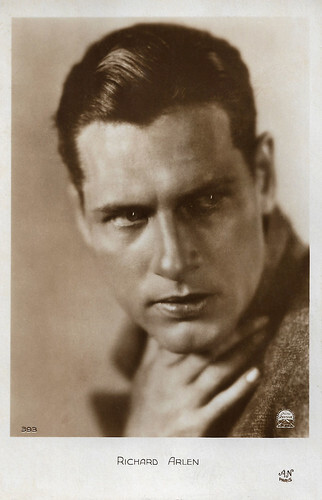
French postcard A.N., Paris, no. 393. Photo: Paramount Pictures Inc.
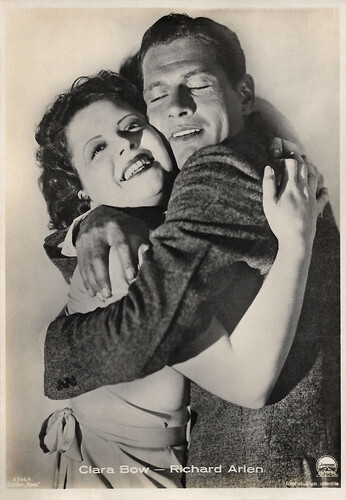
French postcard by Edition Ross, no. 4340/1, 1929-1930. Photo: Paramount. Clara Bow and Richard Arlen in Ladies of the Mob (William A. Wellman, 1928).
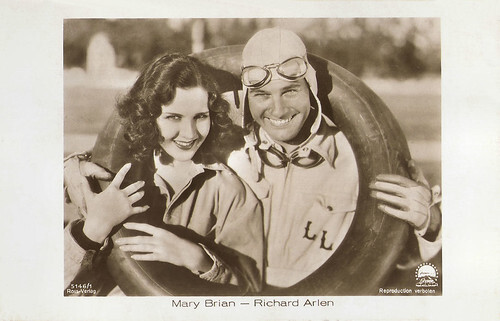
German postcard by Ross Verlag, no. 5146/1, 1930-1931. Photo: Paramount. Mary Brian and Richard Arlen in Burning Up (A. Edward Sutherland, 1930).
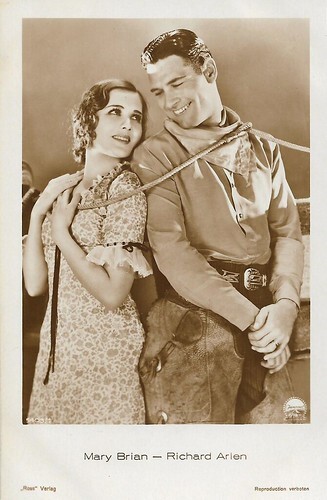
German postcard. by Ross Verlag, no. 5403/1, 1930-1931. Photo: Paramount. Mary Brian and Richard Arlenin The Light of the Western Stars (Otto Dyar, 1930).
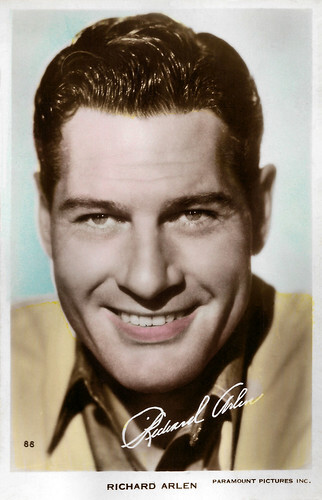
British postcard by Art Photo, no. 88. Photo: Paramount Pictures Inc.
Crashing into the gates of Paramount
Richard Arlen was born Sylvanus Richard Van Mattimore in 1899 (some sources say 1898 or 1900) in St. Paul, Minnesota. Arlen attended the University of Pennsylvania. During World War I, Arlen served in Canada as a pilot in the Royal Canadian Flying Corps. He was assigned the perilous task of taking new planes up to the front lines but he never saw combat.
After the war, he drifted around and eventually wound up in Los Angeles, where he got a job as a motorcycle messenger at a film laboratory. When he was hit by a movie company truck, he crashed into the gates of Paramount Pictures. Arlen suffered a broken leg and the studio provided prompt medical attention. While recuperating in the hospital, studio officials who visited him offered him a chance in pictures, impressed by his good looks.
Starting as an extra in 1921, Arlen soon rose to credited roles, but the quality of his work left much to be desired. His first important film role was in Vengeance of the Deep (Barry Barringer, 1923) starring Ralph Lewis and in which Arlen was billed as Van Mattimore. His big break came when William A. Wellman cast him as a pilot in the silent film Wings (William A. Wellman, 1927) with Charles 'Buddy' Rogers and Clara Bow .
The story of fighter aces would win the Oscar for Best Picture and Arlen would continue to play the tough, cynical hero throughout his career. Arlen appeared in three more pictures directed by Wellman, Beggars of Life (William A. Wellman, 1928), Ladies of the Mob (William A. Wellman, 1928) and The Man I Love (William A. Wellman, 1929).
In Wings (William A. Wellman, 1927), he had a scene with a young actor named Gary Cooper . In 1929, he again worked with Cooper in the Western The Virginian (Victor Fleming, 1929), only this time Cooper was the star and Arlen was the supporting actor.
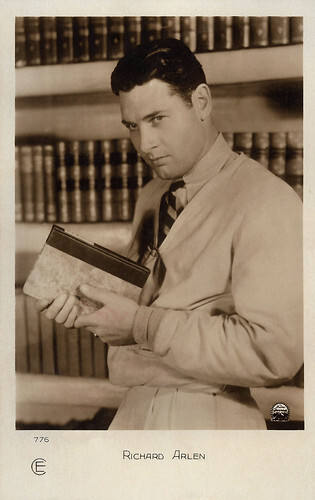
French postcard by Cinémagazine-Edition, Paris (CE), no. 776. Photo: Paramount.
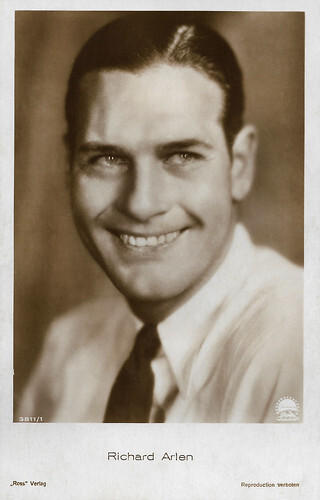
German postcard by Ross Verlag, no. 3911/1, 1928-1929. Photo: Paramount.
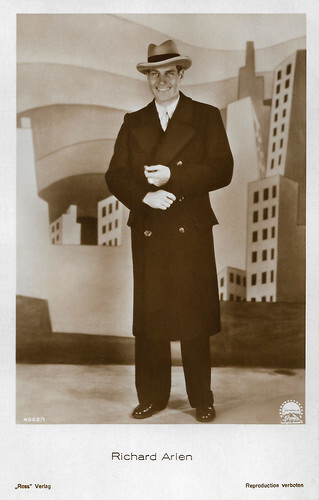
German postcard by Ross Verlag, no. 4002/1, 1929-30. Photo: Paramount.

German postcard by Ross Verlag, no. 5553/1, 1930-1931. Photo: Paramount. Mary Brian and Richard Arlen in the car-racing drama Burning Up (A. Edward Sutherland, 1930).
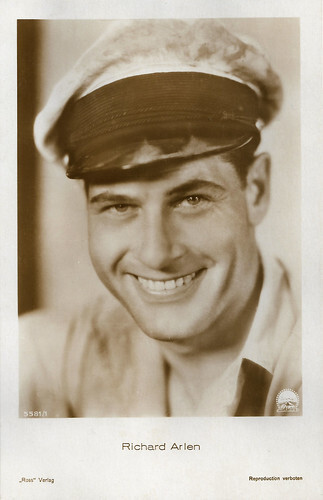
German postcard by Ross Verlag, no. 5581/1, 1930-1931. Photo: Paramount. Richard Arlen in his outfit of The Sea-God (George Abbott, 1930).
His career just bumped along
While Richard Arlen moved easily into sound film, his career just bumped along. It was in 1935 that he became a freelance actor and his freelance career soon waned. He was working in such "B" pictures as Three Live Ghosts (H. Bruce Humberstone, 1936), the Western The Mine with the Iron Door (David Howard, 1936) and the mystery Murder in Greenwich Village (Albert S. Rogell, 1937) with Fay Wray .
In 1939, he signed up with Universal. The studio teamed him with Andy Devine for a series of 14 B-pictures, mostly action comedies with heavy reliance on stock footage from larger-scale films. They are informally known as the "Aces of Action" series, which is how the stars were billed in the trailers. When Arlen left the studio in 1941, the series continued with Devine teamed with a variety of other actors.
In 1941 he moved to the Pine-Thomas unit at Paramount, where he appeared in adventure films and war films. William H. Pine and William C. Thomas were known as "The Dollar Bills" because none of their films ever lost money. Part of the reason Arlen may have made so many for the pair was that he was also a major stockholder in their production company, Pine-Thomas Productions. By the end of the 1940s, Arlen was becoming deaf and this seemed to signal the end of his career. However, he had an operation in 1949 that restored his hearing. In the 1950s and early 1960s, Arlen guest starred in several anthology TV series, including Playhouse 90, The Loretta Young Show, The 20th Century Fox Hour, and in three episodes of the series about clergymen, Crossroads.
He made 15 Westerns for producer A.C. Lyles, who worked with the old Western stars. Besides films and television, Arlen also appeared in commercials. After leaving the business in the late 1960s, he was coaxed back to the screen for three small roles in films, including the comedy Won Ton Ton, the Dog Who Saved Hollywood (Michael Winner, 1976) starring Bruce Dern. Spoofing the craze surrounding the film dog Rin Tin Tin, the film is notable for a large number of cameo appearances by Paramount stars from Hollywood's golden age. Paramount Pictures was the film's distributor.
Richard Arlen was married three times. His first wife was Ruth Austin, from 1920 to 1923. He married his second wife, actress Jobyna Ralston, in 1927. They were among the more famous residents of the celebrity enclave of Toluca Lake, California. The couple had a son, Richard Arlen Jr., who also did some acting. In 1945, the couple divorced and Arlen married New York socialite, Margaret Kinsella in 1946. Arlen died of emphysema in 1976 in North Hollywood at the age of 76 (some sources say 75 or 77). He was interred at Holy Cross Cemetery in Culver City, California.
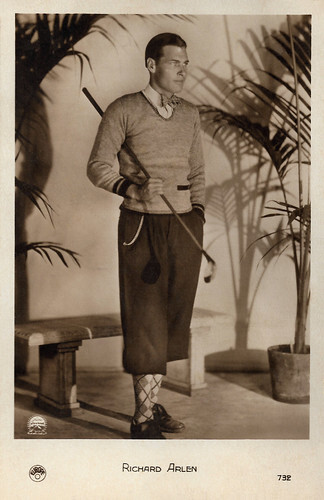
French postcard by Europe, no. 732. Photo: Paramount.
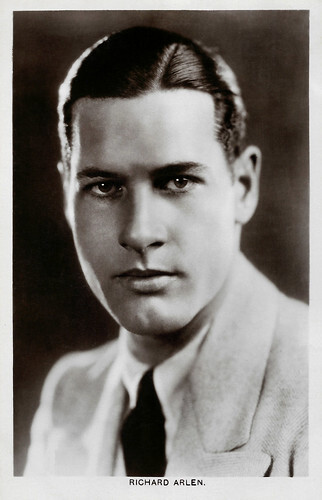
British postcard in the Picturegoer Series, London, no. 350.
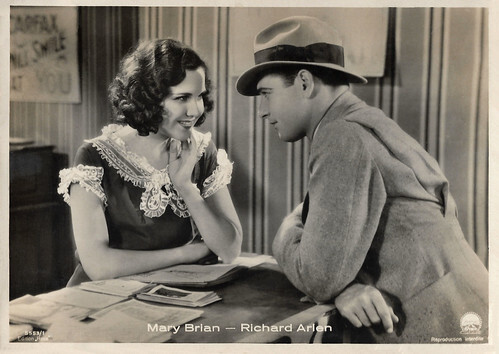
French postcard by Edition Ross, no. 3553/1. Photo: Paramount. Mary Brian and Richard Arlen in the car-racing drama Burning Up (A. Edward Sutherland, 1930).
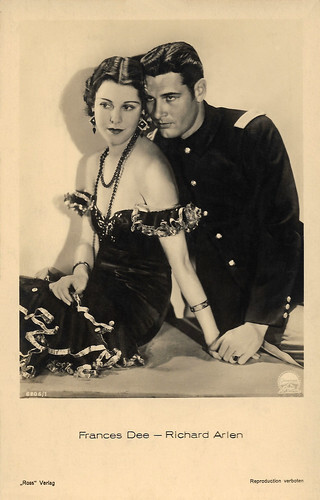
German postcard by Ross Verlag, no. 6206/1, 1931-1932. Photo: Paramount. Frances Dee and Richard Arlen in Caught (Edward Sloman, 1931).
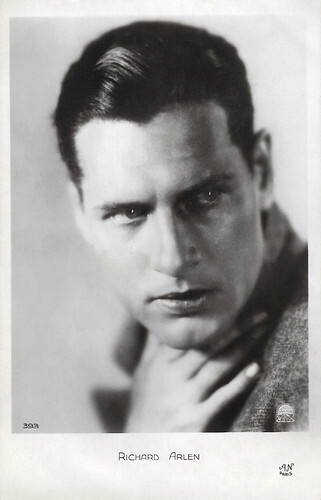
French postcard by A.N., Paris, no. 393. Photo: Paramount.
Sources: (IMDb), Golden Silents, Wikipedia (English, French and German) and .

French postcard A.N., Paris, no. 393. Photo: Paramount Pictures Inc.

French postcard by Edition Ross, no. 4340/1, 1929-1930. Photo: Paramount. Clara Bow and Richard Arlen in Ladies of the Mob (William A. Wellman, 1928).

German postcard by Ross Verlag, no. 5146/1, 1930-1931. Photo: Paramount. Mary Brian and Richard Arlen in Burning Up (A. Edward Sutherland, 1930).

German postcard. by Ross Verlag, no. 5403/1, 1930-1931. Photo: Paramount. Mary Brian and Richard Arlenin The Light of the Western Stars (Otto Dyar, 1930).

British postcard by Art Photo, no. 88. Photo: Paramount Pictures Inc.
Crashing into the gates of Paramount
Richard Arlen was born Sylvanus Richard Van Mattimore in 1899 (some sources say 1898 or 1900) in St. Paul, Minnesota. Arlen attended the University of Pennsylvania. During World War I, Arlen served in Canada as a pilot in the Royal Canadian Flying Corps. He was assigned the perilous task of taking new planes up to the front lines but he never saw combat.
After the war, he drifted around and eventually wound up in Los Angeles, where he got a job as a motorcycle messenger at a film laboratory. When he was hit by a movie company truck, he crashed into the gates of Paramount Pictures. Arlen suffered a broken leg and the studio provided prompt medical attention. While recuperating in the hospital, studio officials who visited him offered him a chance in pictures, impressed by his good looks.
Starting as an extra in 1921, Arlen soon rose to credited roles, but the quality of his work left much to be desired. His first important film role was in Vengeance of the Deep (Barry Barringer, 1923) starring Ralph Lewis and in which Arlen was billed as Van Mattimore. His big break came when William A. Wellman cast him as a pilot in the silent film Wings (William A. Wellman, 1927) with Charles 'Buddy' Rogers and Clara Bow .
The story of fighter aces would win the Oscar for Best Picture and Arlen would continue to play the tough, cynical hero throughout his career. Arlen appeared in three more pictures directed by Wellman, Beggars of Life (William A. Wellman, 1928), Ladies of the Mob (William A. Wellman, 1928) and The Man I Love (William A. Wellman, 1929).
In Wings (William A. Wellman, 1927), he had a scene with a young actor named Gary Cooper . In 1929, he again worked with Cooper in the Western The Virginian (Victor Fleming, 1929), only this time Cooper was the star and Arlen was the supporting actor.

French postcard by Cinémagazine-Edition, Paris (CE), no. 776. Photo: Paramount.

German postcard by Ross Verlag, no. 3911/1, 1928-1929. Photo: Paramount.

German postcard by Ross Verlag, no. 4002/1, 1929-30. Photo: Paramount.

German postcard by Ross Verlag, no. 5553/1, 1930-1931. Photo: Paramount. Mary Brian and Richard Arlen in the car-racing drama Burning Up (A. Edward Sutherland, 1930).

German postcard by Ross Verlag, no. 5581/1, 1930-1931. Photo: Paramount. Richard Arlen in his outfit of The Sea-God (George Abbott, 1930).
His career just bumped along
While Richard Arlen moved easily into sound film, his career just bumped along. It was in 1935 that he became a freelance actor and his freelance career soon waned. He was working in such "B" pictures as Three Live Ghosts (H. Bruce Humberstone, 1936), the Western The Mine with the Iron Door (David Howard, 1936) and the mystery Murder in Greenwich Village (Albert S. Rogell, 1937) with Fay Wray .
In 1939, he signed up with Universal. The studio teamed him with Andy Devine for a series of 14 B-pictures, mostly action comedies with heavy reliance on stock footage from larger-scale films. They are informally known as the "Aces of Action" series, which is how the stars were billed in the trailers. When Arlen left the studio in 1941, the series continued with Devine teamed with a variety of other actors.
In 1941 he moved to the Pine-Thomas unit at Paramount, where he appeared in adventure films and war films. William H. Pine and William C. Thomas were known as "The Dollar Bills" because none of their films ever lost money. Part of the reason Arlen may have made so many for the pair was that he was also a major stockholder in their production company, Pine-Thomas Productions. By the end of the 1940s, Arlen was becoming deaf and this seemed to signal the end of his career. However, he had an operation in 1949 that restored his hearing. In the 1950s and early 1960s, Arlen guest starred in several anthology TV series, including Playhouse 90, The Loretta Young Show, The 20th Century Fox Hour, and in three episodes of the series about clergymen, Crossroads.
He made 15 Westerns for producer A.C. Lyles, who worked with the old Western stars. Besides films and television, Arlen also appeared in commercials. After leaving the business in the late 1960s, he was coaxed back to the screen for three small roles in films, including the comedy Won Ton Ton, the Dog Who Saved Hollywood (Michael Winner, 1976) starring Bruce Dern. Spoofing the craze surrounding the film dog Rin Tin Tin, the film is notable for a large number of cameo appearances by Paramount stars from Hollywood's golden age. Paramount Pictures was the film's distributor.
Richard Arlen was married three times. His first wife was Ruth Austin, from 1920 to 1923. He married his second wife, actress Jobyna Ralston, in 1927. They were among the more famous residents of the celebrity enclave of Toluca Lake, California. The couple had a son, Richard Arlen Jr., who also did some acting. In 1945, the couple divorced and Arlen married New York socialite, Margaret Kinsella in 1946. Arlen died of emphysema in 1976 in North Hollywood at the age of 76 (some sources say 75 or 77). He was interred at Holy Cross Cemetery in Culver City, California.

French postcard by Europe, no. 732. Photo: Paramount.

British postcard in the Picturegoer Series, London, no. 350.

French postcard by Edition Ross, no. 3553/1. Photo: Paramount. Mary Brian and Richard Arlen in the car-racing drama Burning Up (A. Edward Sutherland, 1930).

German postcard by Ross Verlag, no. 6206/1, 1931-1932. Photo: Paramount. Frances Dee and Richard Arlen in Caught (Edward Sloman, 1931).

French postcard by A.N., Paris, no. 393. Photo: Paramount.
Sources: (IMDb), Golden Silents, Wikipedia (English, French and German) and .
Published on January 19, 2023 22:00
January 18, 2023
Loni von Friedl
Loni von Friedl (1943) is an Austrian film and television actress. She began as a child actress in the early 1950s, before graduating to mature roles during the following decade. The daughter of cinematographer Fritz von Friedl, she also has an actor brother of the same name. Her nephew is actor Christoph von Friedl. She was married to actor Götz George from 1966 to 1976. She later married Jürgen Schmidt.
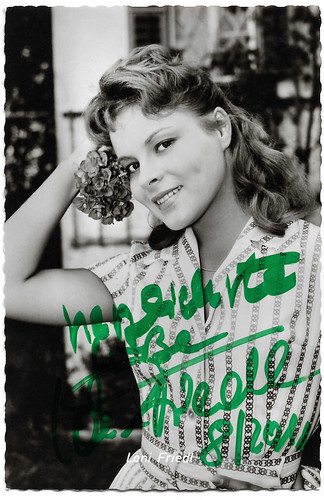
West-German postcard by Kolibri-Verlag, Minden/Westf, no. 1362.
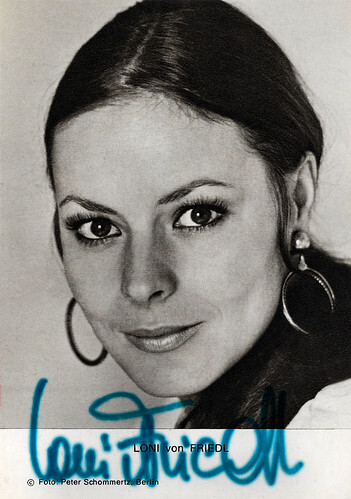
West-German postcard by Franz Josef Rüdel, Filmpostkartenverlag, Hamburg. Photo: Peter Schommertz, Berlin.
The youngest ensemble member of the Burgtheater
Loni von Friedl was born Leontine Anna Maria Friedl von Liebentreu in 1943 in Vienna, Austria. Her parents, the Austrian cameraman Fritz von Friedl and his wife, had returned to Vienna to escape the Allied air raids on Berlin in 1943. Loni was born shortly afterwards.
Loni took on children's roles on stage and radio at an early age. Her film career began in 1950 when, at the age of seven, she appeared in the English children's film, The Lone Climber (William C. Hammond, 1949).
The following year, together with her brother Fritz (Vinzenz as a child), who was two years older, she played the role of little Annamirl Raudaschl in the musical comedy Der fidele Bauer/The Merry Farmer (Georg Marischka, 1951) starring alongside Paul Hörbiger .
After her school years, she took ballet lessons with Pia Lucca and three years of acting lessons with Vera Balser-Eberle in Vienna. In 1958 Loni von Friedl got an engagement at the famous Burgtheater in Vienna, where she became the youngest ensemble member in 1962. She acted at the Burgtheater until 1965.
She also appeared at the Städtische Bühnen in Cologne (1958-1959), the Kleine Komödie in Munich (1961) and the Renaissance Theatre in Berlin (1962). She made several guest appearances at the Thalia Theatre in Hamburg. In 1966-1967 she appeared at the Munich Residenztheater, and then at the Berlin Schillertheater.
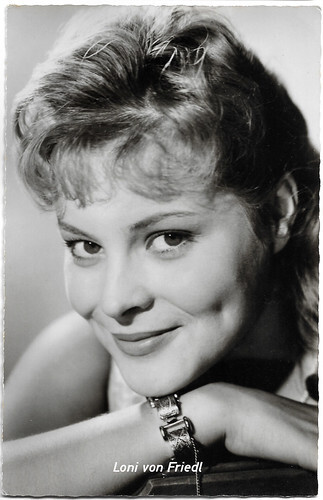
West-German postcard by Kolibri-Verlag G.m.b.H., Minden/Westf, no. 1808.
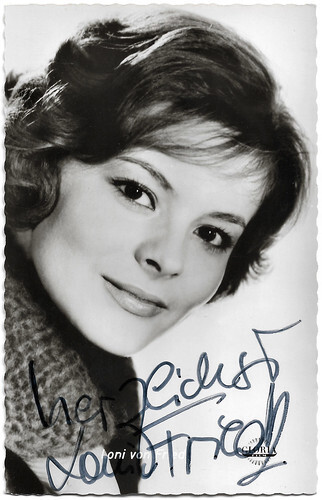
West-German postcard by Kolibri-Verlag G.m.b.H., Minden/Westf, no. 1596. Photo: Gabriele / Alfa / Gloria Film. Loni von Friedl in Zu jung für die Liebe/Too young for love? (Erica Balqué, Helmut Käutner, 1961).
Best Newcomer Actress
In 1962, Loni von Friedl received the Filmband in Gold in the category "Best Newcomer Actress" at the German Film Awards, for her role in the Berlin film Zwei unter Millionen/Two Among Millions (Wieland Liebske, Victor Vicas, 1961), in which Hardy Krüger was her partner.
She also won for her role in the Swiss-German film drama Die Schatten werden länger/The Shadows Grow Longer (Ladislao Vajda, 1961) in which she appeared alongside Luise Ullrich , Barbara Rütting and Hansjörg Felmy.
.
In the US war film The Blue Max (John Guillermin, 1966), she starred alongside George Peppard, James Mason and Ursula Andress . Von Friedl also had a role in the British science fiction film Doppelgänger/Journey to the far side of the Sun (Robert Parrish. 1969), about a journey to the mythical Counter-Earth.
She subsequently appeared in other films. From 1973 to 1975 and again from 1980-1981, she belonged to the ensemble of the Staatliche Schauspielbühnen Berlin, from 1976 to 1980 she was under contract at the Thalia Theatre in Hamburg, and most recently again at the Schillertheater in 'Die Katze auf dem heißen Blechdach' (Cat on a hot tin Roof).
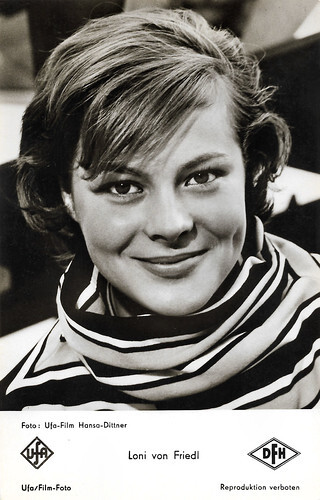
West German postcard by Ufa/Film-Foto, Berlin-Tempelhof, no. FK 5159. Photo: Ufa-Film / Deutsche Film Hansa / Dittner. Loni von Friedl in Zwei unter Millionen/Two Among Millions (Wieland Liebske, Victor Vicas, 1961).
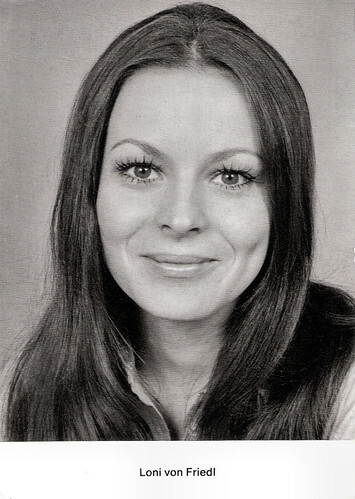
West-German postcard by Franz Josef Rüdel, Filmpostkartenverlag, Hamburg. Photo: Schweigmann, Hamburg.
Solo for Bette Davis
Since the 1970s Loni von Friedl has also been a busy TV actress. In the adventure series Diamantendetektiv Dick Donald/Diamond Detective Dick Donald (1971), she played assistant Daisy alongside her then-husband Götz George , who played the title role.
From 1984 to 1991, von Friedl appeared as the doctor Dr. Ingrid Probst in 20 episodes of the television series Ein Heim für Tiere/A Home for Animals (1984-1991) which revolved around the veterinary practice of Dr. Willi Bayer, portrayed by Siegfried Wischnewski.
In 1986 she appeared in 12 episodes of the family series Teufels Großmutter/Devil's Grandmother, in which she played Hetty, the daughter of Dorothea Teufel, portrayed by Brigitte Horney. In 1987 and 1988 she played one of the family members of the large Kurwaski family, who run the Waldhaus country hotel together, in 18 episodes.
In the comedic television series Peter and Paul, which ran on television from 1994 to 1998, Von Friedl played the role of Freifrau von Rabenberg. Helmut Fischer and Hans Clarin were the eponymous main characters Peter and Paul, two mayors by marriage. Her last role to date was in two episodes of the television series Um Himmels Willen (2018).
In June 2007, Loni von Friedl appeared on stage at the St. Pauli Theatre in Hamburg as Bette Davis in 'Solo for Bette', a play she had written in collaboration with Horst Königstein. She also performed this play in Berlin at the O-TonArt theatre in 2010. One of Königstein's students, Julia Bossert, shot her film diploma thesis (screenplay and direction) Elli & Richard (2013) with Von Friedl. This film received the audience award at the festival in Kyoto.
Loni von Friedl was married to Götz George from 1966 to 1976. From this marriage came Tanja George, who lives in Australia and works as a sculptor. In her second marriage, Von Friedl was married from 1995 to the actor Jürgen Schmidt, who died of leukaemia in November 2004 in Munich, where she still lives today. Loni von Friedl's brother Fritz von Friedl and her nephew Christoph von Friedl are also actors.
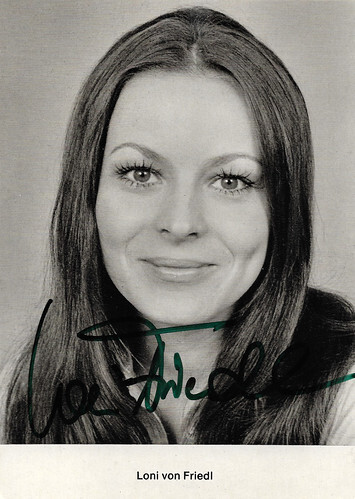
West German postcard by Franz Josef Rüdel, Filmpostkartenverlag, Hamburg. Photo: Schweigmann, Berlin.
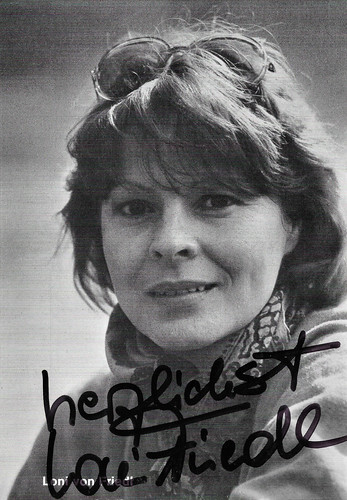
German autograph card.
Sources: Wikipedia (German and English) and .

West-German postcard by Kolibri-Verlag, Minden/Westf, no. 1362.

West-German postcard by Franz Josef Rüdel, Filmpostkartenverlag, Hamburg. Photo: Peter Schommertz, Berlin.
The youngest ensemble member of the Burgtheater
Loni von Friedl was born Leontine Anna Maria Friedl von Liebentreu in 1943 in Vienna, Austria. Her parents, the Austrian cameraman Fritz von Friedl and his wife, had returned to Vienna to escape the Allied air raids on Berlin in 1943. Loni was born shortly afterwards.
Loni took on children's roles on stage and radio at an early age. Her film career began in 1950 when, at the age of seven, she appeared in the English children's film, The Lone Climber (William C. Hammond, 1949).
The following year, together with her brother Fritz (Vinzenz as a child), who was two years older, she played the role of little Annamirl Raudaschl in the musical comedy Der fidele Bauer/The Merry Farmer (Georg Marischka, 1951) starring alongside Paul Hörbiger .
After her school years, she took ballet lessons with Pia Lucca and three years of acting lessons with Vera Balser-Eberle in Vienna. In 1958 Loni von Friedl got an engagement at the famous Burgtheater in Vienna, where she became the youngest ensemble member in 1962. She acted at the Burgtheater until 1965.
She also appeared at the Städtische Bühnen in Cologne (1958-1959), the Kleine Komödie in Munich (1961) and the Renaissance Theatre in Berlin (1962). She made several guest appearances at the Thalia Theatre in Hamburg. In 1966-1967 she appeared at the Munich Residenztheater, and then at the Berlin Schillertheater.

West-German postcard by Kolibri-Verlag G.m.b.H., Minden/Westf, no. 1808.

West-German postcard by Kolibri-Verlag G.m.b.H., Minden/Westf, no. 1596. Photo: Gabriele / Alfa / Gloria Film. Loni von Friedl in Zu jung für die Liebe/Too young for love? (Erica Balqué, Helmut Käutner, 1961).
Best Newcomer Actress
In 1962, Loni von Friedl received the Filmband in Gold in the category "Best Newcomer Actress" at the German Film Awards, for her role in the Berlin film Zwei unter Millionen/Two Among Millions (Wieland Liebske, Victor Vicas, 1961), in which Hardy Krüger was her partner.
She also won for her role in the Swiss-German film drama Die Schatten werden länger/The Shadows Grow Longer (Ladislao Vajda, 1961) in which she appeared alongside Luise Ullrich , Barbara Rütting and Hansjörg Felmy.
.
In the US war film The Blue Max (John Guillermin, 1966), she starred alongside George Peppard, James Mason and Ursula Andress . Von Friedl also had a role in the British science fiction film Doppelgänger/Journey to the far side of the Sun (Robert Parrish. 1969), about a journey to the mythical Counter-Earth.
She subsequently appeared in other films. From 1973 to 1975 and again from 1980-1981, she belonged to the ensemble of the Staatliche Schauspielbühnen Berlin, from 1976 to 1980 she was under contract at the Thalia Theatre in Hamburg, and most recently again at the Schillertheater in 'Die Katze auf dem heißen Blechdach' (Cat on a hot tin Roof).

West German postcard by Ufa/Film-Foto, Berlin-Tempelhof, no. FK 5159. Photo: Ufa-Film / Deutsche Film Hansa / Dittner. Loni von Friedl in Zwei unter Millionen/Two Among Millions (Wieland Liebske, Victor Vicas, 1961).

West-German postcard by Franz Josef Rüdel, Filmpostkartenverlag, Hamburg. Photo: Schweigmann, Hamburg.
Solo for Bette Davis
Since the 1970s Loni von Friedl has also been a busy TV actress. In the adventure series Diamantendetektiv Dick Donald/Diamond Detective Dick Donald (1971), she played assistant Daisy alongside her then-husband Götz George , who played the title role.
From 1984 to 1991, von Friedl appeared as the doctor Dr. Ingrid Probst in 20 episodes of the television series Ein Heim für Tiere/A Home for Animals (1984-1991) which revolved around the veterinary practice of Dr. Willi Bayer, portrayed by Siegfried Wischnewski.
In 1986 she appeared in 12 episodes of the family series Teufels Großmutter/Devil's Grandmother, in which she played Hetty, the daughter of Dorothea Teufel, portrayed by Brigitte Horney. In 1987 and 1988 she played one of the family members of the large Kurwaski family, who run the Waldhaus country hotel together, in 18 episodes.
In the comedic television series Peter and Paul, which ran on television from 1994 to 1998, Von Friedl played the role of Freifrau von Rabenberg. Helmut Fischer and Hans Clarin were the eponymous main characters Peter and Paul, two mayors by marriage. Her last role to date was in two episodes of the television series Um Himmels Willen (2018).
In June 2007, Loni von Friedl appeared on stage at the St. Pauli Theatre in Hamburg as Bette Davis in 'Solo for Bette', a play she had written in collaboration with Horst Königstein. She also performed this play in Berlin at the O-TonArt theatre in 2010. One of Königstein's students, Julia Bossert, shot her film diploma thesis (screenplay and direction) Elli & Richard (2013) with Von Friedl. This film received the audience award at the festival in Kyoto.
Loni von Friedl was married to Götz George from 1966 to 1976. From this marriage came Tanja George, who lives in Australia and works as a sculptor. In her second marriage, Von Friedl was married from 1995 to the actor Jürgen Schmidt, who died of leukaemia in November 2004 in Munich, where she still lives today. Loni von Friedl's brother Fritz von Friedl and her nephew Christoph von Friedl are also actors.

West German postcard by Franz Josef Rüdel, Filmpostkartenverlag, Hamburg. Photo: Schweigmann, Berlin.

German autograph card.
Sources: Wikipedia (German and English) and .
Published on January 18, 2023 22:00
Paul van Yperen's Blog
- Paul van Yperen's profile
- 13 followers
Paul van Yperen isn't a Goodreads Author
(yet),
but they
do have a blog,
so here are some recent posts imported from
their feed.



